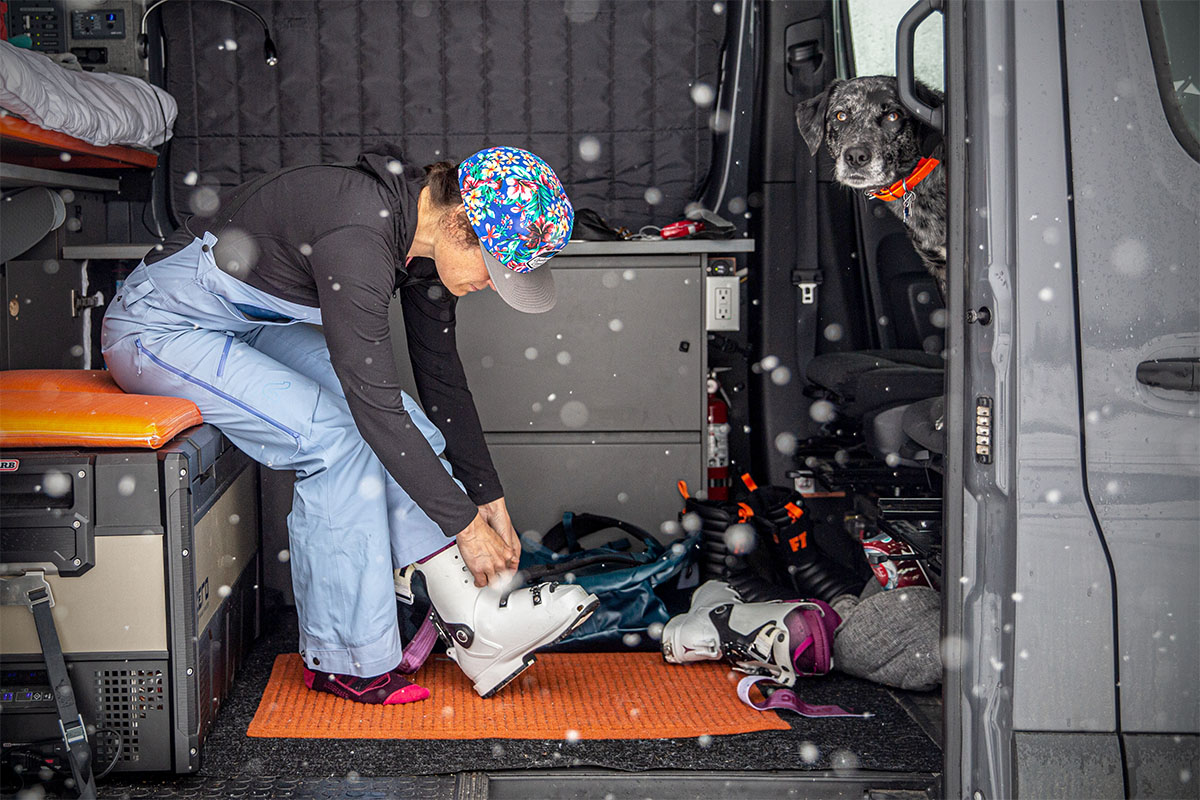
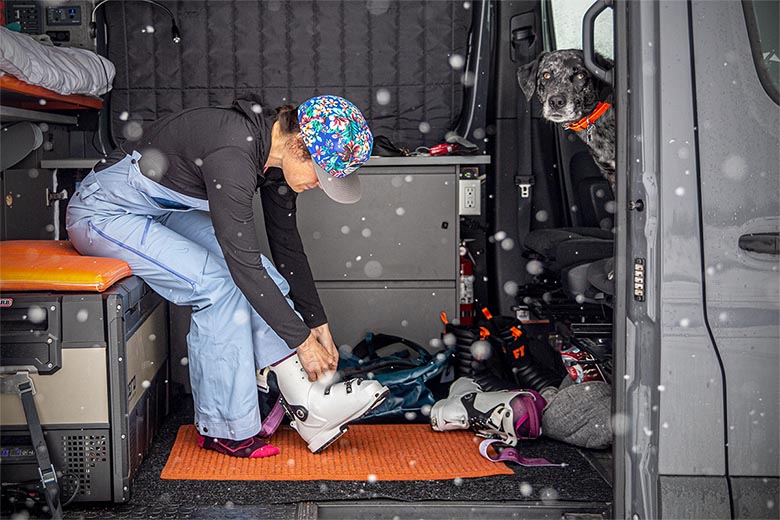
We can’t overstate the importance of choosing the right boots for your feet, whether you're just starting out or have been skiing for years. And while there has been progress in the development of women's ski gear, it's important to note that some women's-specific designs don't reach the same performance standard as unisex boots. We'd like to acknowledge that for hard-charging women, sometimes the best option will be a unisex or men's boot. That said, the industry has come a long way, and there are now some great options built specifically for the ladies. We put boots to the test from Sun Valley to Stevens Pass, walking into the mountains for long missions in the Tetons and the Sawtooths to see which models outperform the rest. Below are our picks for the best women’s-specific ski boots for the 2024-25 season. For more background information, see our comparison table and buying advice below the picks. To complete your downhill kit, check out our articles on the best women’s all-mountain skis, best ski bindings, and our ski boot and binding compatibility guide.
Editor's note: We updated this guide on September 19, 2024, to provide more information on boot-punching modifications and add a walk mode comparison metric. We also updated our list to include a hybrid boot, an all-mountain boot with walk mode, an option for hard chargers, and our pick for the best backcountry ski boot. Stay tuned as we build out a women's backcountry ski boot round-up for the 2025-26 season.
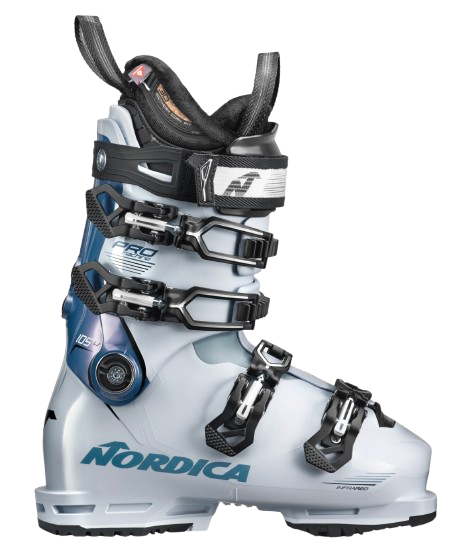 Last: 98mm
Last: 98mm
Flex: 105 (intermediate/advanced skiers)
Other flexes: 85, 95, 115
Weight (per boot): 1810g
Walk mode?: No
What we like: A high-performance boot that’s actually comfortable.
What we don’t: Low-volume shape doesn’t accommodate wide feet.
For experienced skiers who explore the whole mountain but don’t want the stiffest boot on the market, the Nordica Promachine 105 offers a hard-to-beat balance of power, comfort, and price. Nordica achieves this best-of-both-worlds feel by incorporating stiffer materials along the boot’s spine for lateral rigidity and control, while softer materials on the top of the instep offer a predictable, forgiving flex and easy on/off. The low-volume width (98mm) is decidedly performance-focused, but the plush, Primaloft-insulated liner and cork around the ankle add a nice dose of comfort for long days on the hill. The boots can also be heat molded to eliminate hot spots and better dial in fit, and the included 3D Custom Cork Liner will give you performance well beyond most other stock liners.
What’s not to like with the Nordica Promachine 105? Fit is always the biggest equalizer with boots, and women with wide or high-volume feet will likely want to opt for something with a little more room. If you fall into this bracket, it’s worth checking out the K2 BFC 95 or Dynafit Radical Pro below, both of which offer a comparable flex to the Promachine but with a slightly wider last. But if the moderately snug shape works for your feet, we think the Promachine (complete with a GripWalk sole) hits a real sweet spot in the resort boot market, earning it our top ranking for the 2024-2025 season.
See the Nordica Promachine 105 W
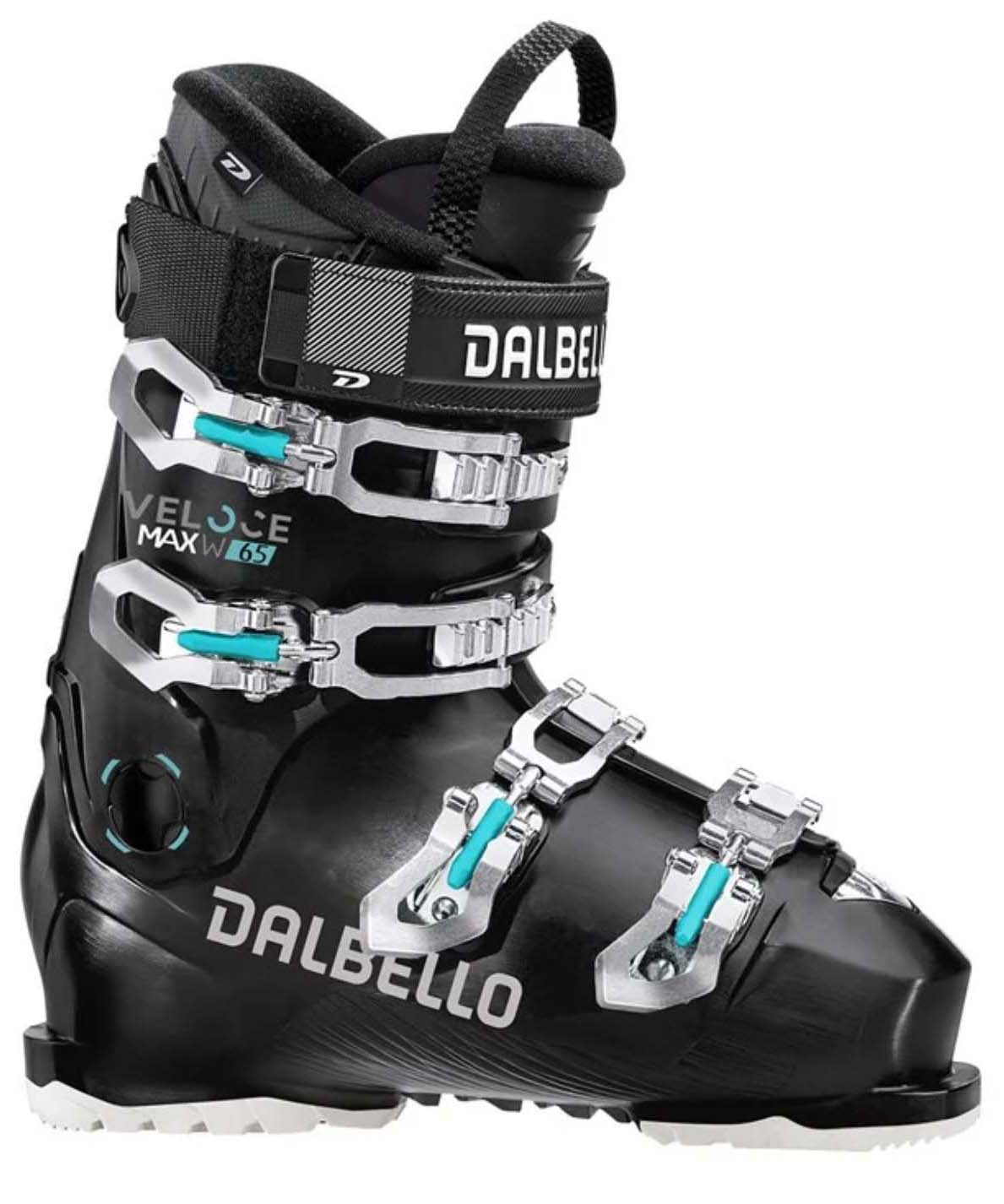 Last: 103mm (wide)
Last: 103mm (wide)
Flex: 65 (beginner/intermediate skiers)
Other flex: 80
Weight (per boot): 1730g
Walk mode?: No
What we like: A thoughtfully built, beginner-friendly design at a great price.
What we don’t: Progressing intermediates will quickly outgrow this boot.
Learning to ski is challenging enough without uncomfortable boots and achy toes thrown in the mix, which is why Dalbello’s plush and beginner-friendly Veloce Max 65 is our favorite option for new skiers. This soft and forgiving boot prioritizes comfort with a 103-millimeter last and high-volume shape that will accommodate most feet with minimal break-in required. Further, the aptly named Supercomfort liner is warm and well cushioned for full days of lessons and laps, and the lower shell is contoured to minimize pain in common pressure-point areas like the ankle, heel, top of the forefoot, and outer toes. To top it off, the boots' GripWalk soles will help new skiers stay upright while learning to navigate icy parking lots and slippery ski lodge staircases.
While the Dalbello Veloce Max 65 is an excellent choice for beginners building their skills, the boot’s soft flex and plush comfort mean that progressing intermediate riders will outgrow it sooner rather than later. Skiers who can confidently link turns on green runs but still want a comfortable all-day boot will be better off with a slightly stiffer option like the Nordica Sportmachine 3 75 ($400) or Lange LX 75 HV ($480). Although both alternatives come with a higher price tag, quickly advancing riders will appreciate the efficient power transfer and responsiveness they get with very little trade-off in overall comfort. On the other hand, it’s hard to beat the value of the Veloce Max 65, making it an approachable but capable pick for riders graduating from their first turns to the bunny slopes and beyond. For more beginner ski boot picks, be sure to check out our beginner ski boot round-up.
See the Dalbello Veloce Max 65 W
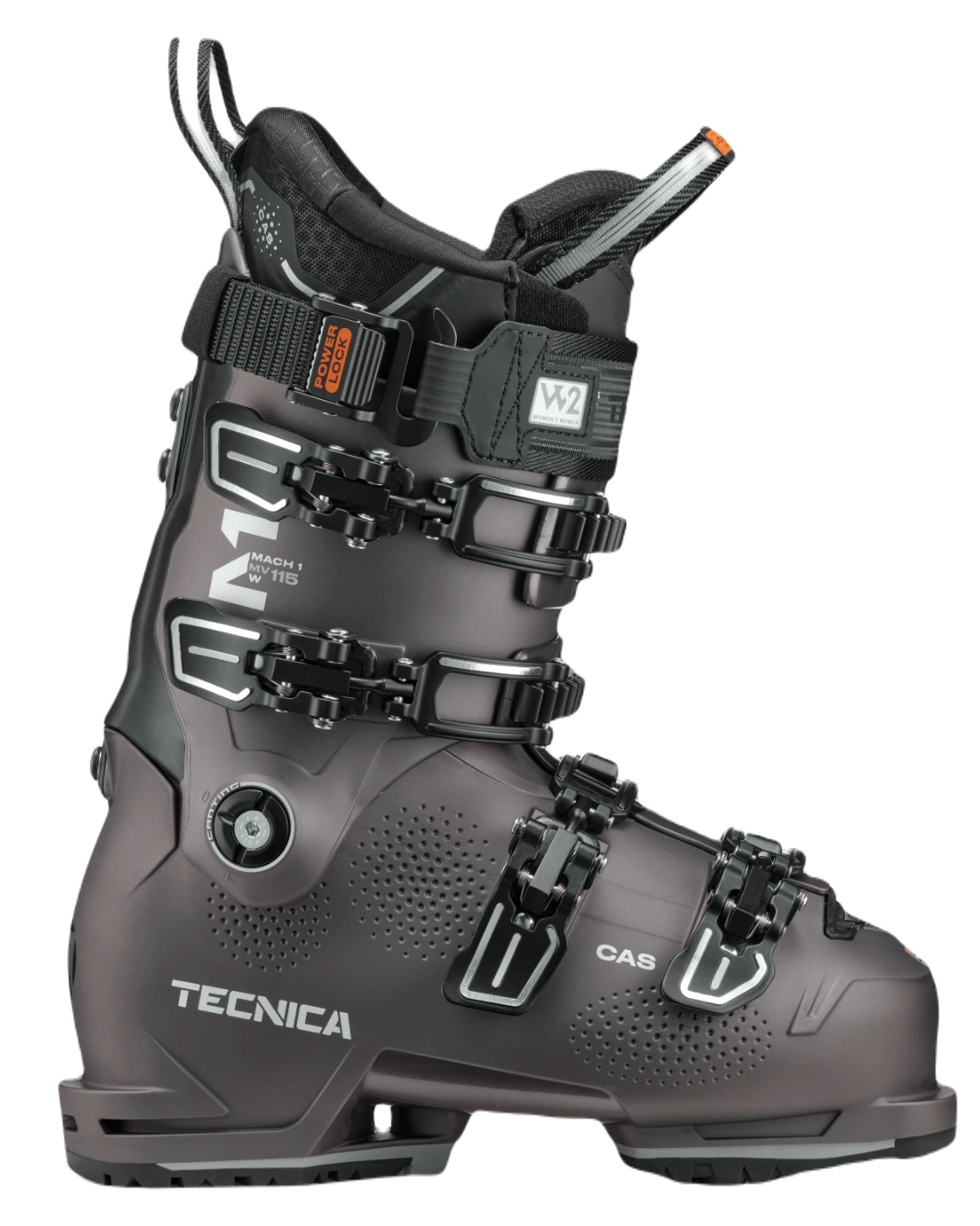 Last: 98mm (LV) or 100mm (MV)
Last: 98mm (LV) or 100mm (MV)
Flex: 115 (advanced/expert skiers)
Other flexes: 95, 105
Weight (per boot): 1630g
Walk mode?: No
What we like: This aptly named boot rips, and the latest model features GripWalk soles.
What we don’t: A bit too rigid in the chop.
For women who love squeezing the throttle from the top to the bottom, the Tecnica Mach1 LV 115 has no problem handling the speed. With a stiff 115 flex and Tecnica's T-Drive technology creating a "stronger and more effective connection between the cuff and the shell", the Mach1 is very responsive and efficient at transferring energy through each turn. It’s also comfortable and extremely customizable, making it a great choice for former ski racers who are looking for a high-performing daily driver (the new GripWalk soles also make it a friendlier hiking partner). Tecnica’s C.A.S. (short for “Custom Adaptive Shape”) shell and liner are anatomically shaped with a narrower fit through the midfoot and just enough breathing room around the toes. The dimpled texture on the shell also allows it to be easily manipulated through heat molding to get the best possible fit for your foot.
While highly customizable and comfortable for such a stiff performance boot, there’s no getting around the fact that the Tecnica Mach1 115 demands a strong skier who’s willing to drive aggressively. Otherwise, the boot feels too rigid and difficult to control when moving at a slower clip, especially in choppy snow. Available in both medium-volume 100-millimeter and low-volume 98-millimeter last options, this boot will fit best on those with average to narrower feet. If you want something a bit wider, check out K2's BFC series below. All together, the Mach1 W's comfort belies its impressive downhill power and prowess. A final note: While this boot is near the top of the recreational market for hard-charging skiers, if you want the stiffest of the stiff, it's best to look into race boots.
See the Tecnica Mach1 LV 115 W TD GW
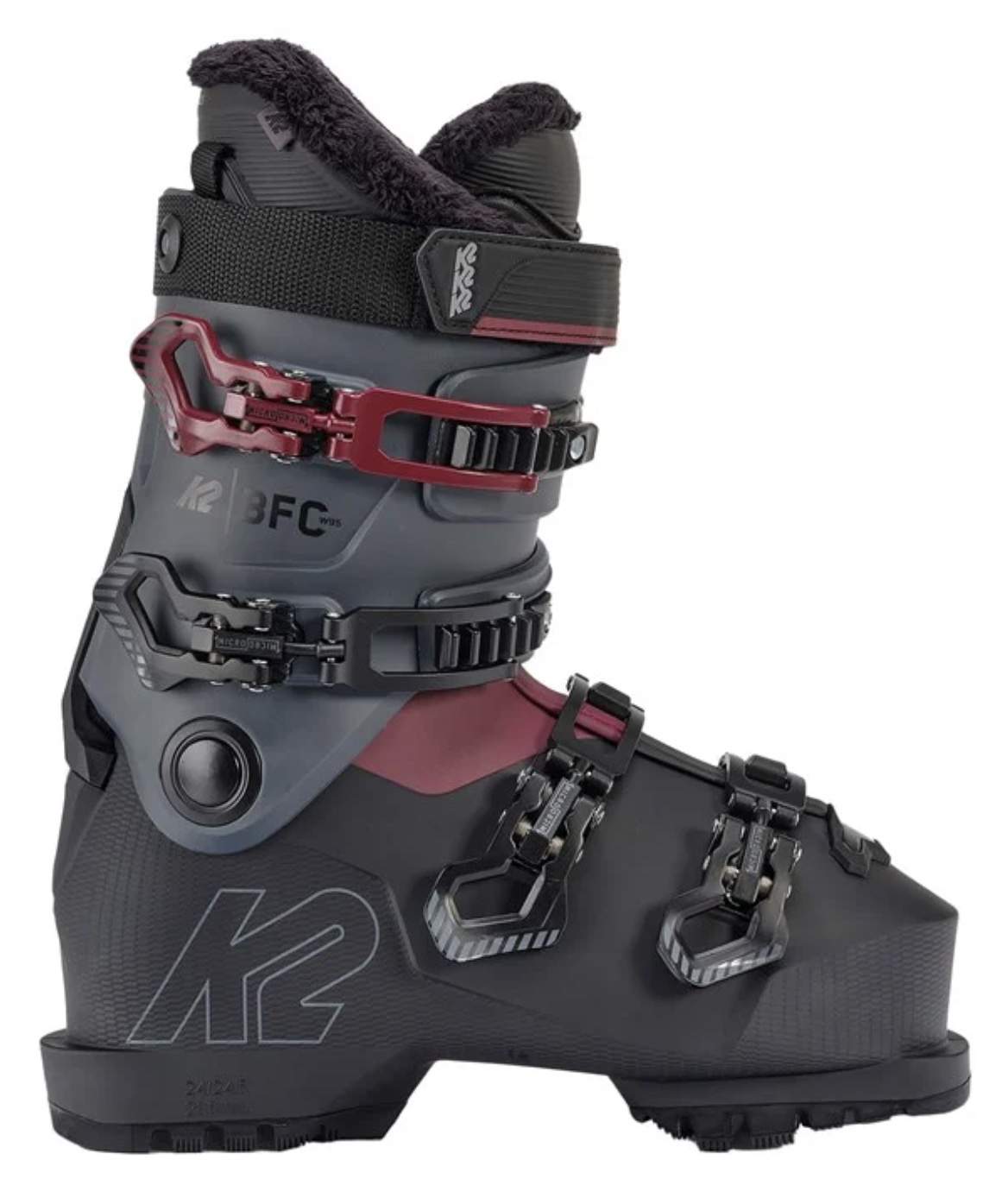 Last: 103mm
Last: 103mm
Flex: 95 (intermediate/advanced skiers)
Other flexes: 75, 85, 105
Weight (per boot): 1792g
Walk mode?: No
What we like: Excellent balance of comfort and precision for those with higher-volume feet.
What we don’t: Unsurprisingly, the high-volume fit impacts power transfer.
Riding in a performance boot doesn’t have to be uncomfortable, as proven by K2’s BFC 95. If you’ve got wide feet, large calves, or simply like a bit more room for your toes to relax and splay, the BFC (short for “Built for Comfort”) could be just the ticket. With a 103-millimeter last, this boot is roomy enough for almost any foot shape but doesn’t come with any major sacrifices in performance. The women’s model is available in four flexes from 75 to 105, though we like the moderately stiff 95 best for its effective balance of forgiveness and precision. There is also a BOA closure model available for the 95 and 105 flex options to ease customizing tightness if you're willing to spend up. The boot’s TPU shell and cuff can be heat-molded for a custom fit, and its four aluminum buckles are glove-friendly and provide a secure, even cinch around the entire foot. Finally, the BFC’s GripWalk soles ensure that the walk to après will be just as smooth as your turns.
The BFC series is made with high-volume feet in mind, intending to provide a high-performance option for those who don’t fit into the standard mold. That being said, while the K2 BFC provides excellent comfort, some performance is lost due to less power transfer from the fit. The Dynafit Radical Pro below is only compatible with MNC bindings (causing it to rank lower), but it has the same 103-millimeter last, and testers felt it performed much better. And for skiers with narrow or low-volume feet, we'd suggest K2’s Anthem 95 or Anthem 105 below, which come in at a similar price point ($500 and $600, respectively) and offer a similarly great balance between comfort and performance in a narrower, 100-millimeter last.
See the K2 BFC 95
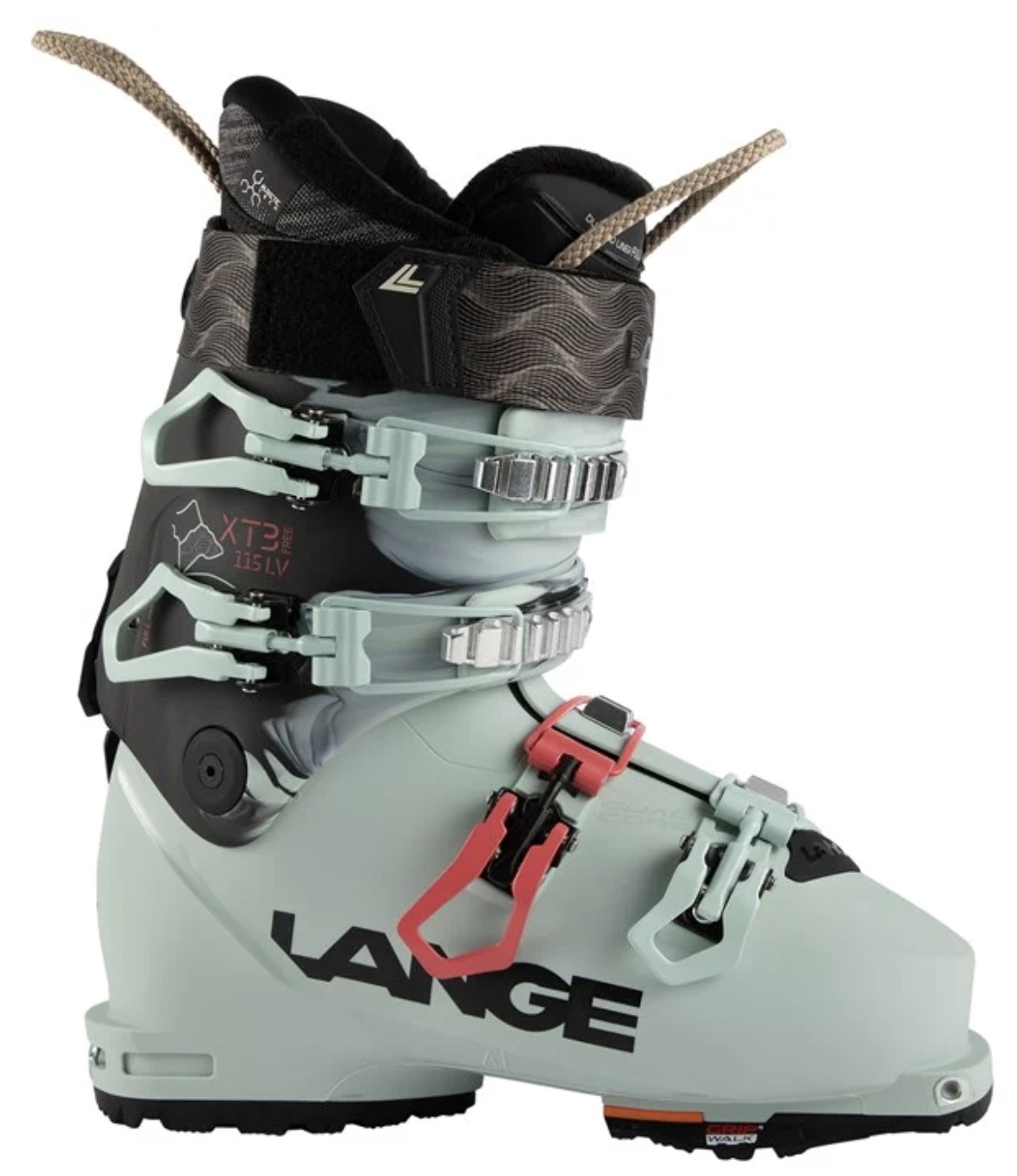 Last: 97mm (LV) or 100mm (MV)
Last: 97mm (LV) or 100mm (MV)
Flex: 115 (advanced/expert skiers)
Other flex: 95
Weight (per boot): 1614g
Walk mode?: Yes
What we like: Excellent performance all over the mountain.
What we don’t: Walk mode range of motion isn't up to par with true touring boots.
A favorite amongst ski patrollers, the Lange XT3 is a true workhorse of a ski boot. Featuring the brand's Dual Core Light technology, this boot flexes with the same snappy pop as Lange's downhill offerings while still providing a walk mode to keep long days at the mountain, bootpacking inbounds, and chilling on the deck comfy. The XT3 also comes with a removable dual-position highback, or "spoiler", to make room for different calf sizes. We also like the new lightweight Performance Boot Board footbed, which is better than most stock options on the market. And the fact that they're offered in both a low-volume (LV) and medium-volume (MV) option makes the XT3s appealing to a wide range of skiers.
With so many fun features, what's not to like with the Lange XT3 Free? First, while we appreciate the walk mode, we've found in testing that it's more limited compared to others on the market and in this lineup. In other words, while the XT3 thrives as an inbounds, all-mountain option, we wouldn't recommend it as a daily driver in the backcountry. Additionally, the 97- and 100-millimeter lasts might be a bit too narrow without punching for folks with wider feet. However, if you're going to be working at a ski hill or just average a high number of days in ski boots doing everything from making turns to hiking ridges to putzing around the parking lot, these are a great choice.
See the Lange XT3 Free 115 LV See the Lange XT3 Free 115 MV
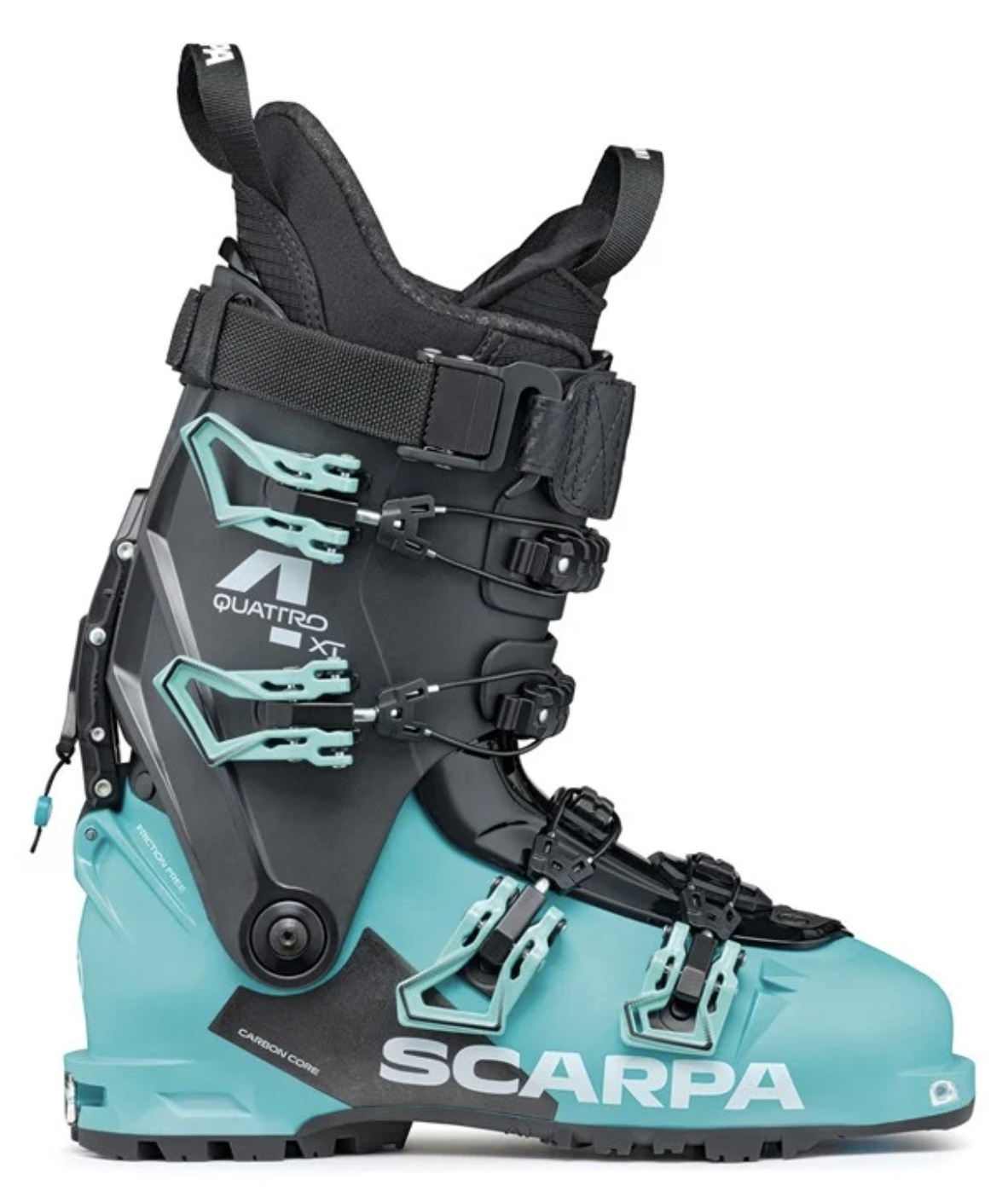 Last: 100mm
Last: 100mm
Flex: 115 (advanced/expert skiers)
Other flex: 100 (SL Model)
Weight (per boot): 1345g
Walk mode?: Yes
What we like: Incredible downhill performance while still charging uphill.
What we don’t: Feels narrower than the 100mm last suggests; GripWalk soles are not replaceable.
Scarpa joined the market of true hybrid up/downhill boots in 2022. As a follow-up to their bestselling Gea RS, they made the 4-Quattro series more versatile by offering compatibility with GripWalk alpine bindings as well as tech bindings (ISO 23223 and 9523). While we've spent the majority of the past few years contemplating if the boot's intended name is pronounced "four-four" or just "four" (the number of buckles), there is no doubt this boot is at the top of the women's-specific hybrid category. In line with what our male testers found, the women's Quattro excels on the downhill without compromising much on the up. With a stellar 61-degree ROM (range of motion) at just 1290 grams per boot in a 24.0/25.0 pair, this boot feels like a true alpine boot when locked down and transfers power similarly to the heavier and stiffer Gea. To up the ante, Scarpa also offers the $100-cheaper 4-Quattro SL model, which features a 100 flex and is even lighter.
Despite the comfort of the stock liner, durability, and performance of the 4-Quattro XT, there are some drawbacks. As is true with every boot on the hybrid market, the 4-Quattro does not perform like a true touring boot or an alpine boot. Resort-heavy skiers will miss some of the sturdiness and performance of a traditional alpine boot, while those heading out on far-reaching tours into the backcountry will want something with less weight, like the Women's F1 LT ($949). Another downside is that the albeit grippy and high-performance GripWalk Vibram soles cannot be replaced—this is the norm for dedicated touring models, but if you’re used to being able to swap the toes and heels on your downhill boots, you may be disappointed. That said, the 4-Quattro is the best at exactly what it claims: Jill of all trades, master of none, but a master of fun... Read in-depth review (men's version)
See the Scarpa 4-Quattro XT See the Scarpa 4-Quattro SL
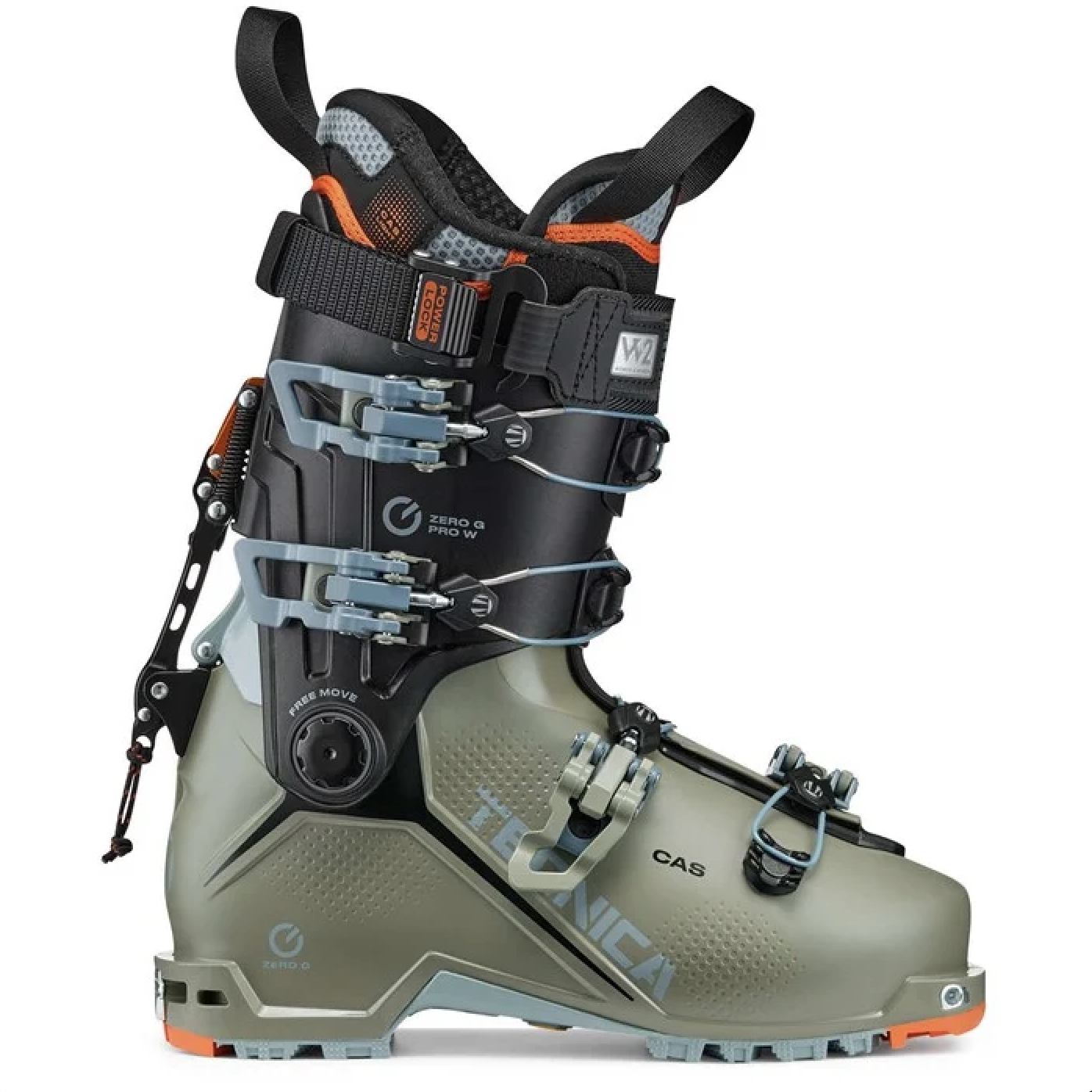 Last: 99mm
Last: 99mm
Flex: 125 (advanced/expert skiers)
Other flex: 105 (non-Pro version)
Weight (per boot): 1128g
Walk mode?: Yes
What we like: A capable one-quiver boot for on- and off-piste use; first of its flex for women.
What we don’t: Narrower fit and high price point.
For years, if you headed out into the backcountry, you'd see loads of hard-charging skiers—both men and women—in the men's Tecnica Zero G Tour Pro. The somewhat iconic orange boots were one of the only touring-capable boots with a high ROM for uphill that still boasted a 130 flex rating. Some women (this editor included) have spent years lamenting the lack of a women's-specific option, as the unisex shell didn't work well for shorter legs/wider calves—until now. Following brands like Dynafit that released stiffer women's-specific touring boots like the Radical Pro W below (110 flex), Tecnica all but breaks the market in 2025 with the 125-flex Zero G Pro Tour just for the ladies. Boasting a 60-degree ROM for long walks in the hills, this boot is a solid companion for laying down powerful turns high in the mountains. A member of Tecnica's most-developed ski boot family, this year's Zero G steps it up from past iterations with a 1-millimeter-higher instep to make getting into the boots easier, an additional 1.5 degrees of forward lean to keep you out of the backseat, increased lateral stiffness, and a more anatomical foot shape.
The most common use case for the Zero G Tour Pro was as a hybrid resort/backcountry boot, but Tecnica's recent weight reduction makes it even more capable for the latter. That said, there are still lighter boots that'll make it easier to go farther into the hills, like the Scarpa F1 LT. And though the $900 price point and 125 flex make the Zero G a premium selection for experienced skiers, for those who don't get out quite as frequently or are newer to skiing, it might be too much boot—both in terms of price and performance. Tecnica does offer a 105-flex non-Pro model for $700, which is 372 grams heavier per boot and not quite as stiff. Finally, the 99-millimeter last and general shape of Tecnica boots is a bit narrow for wider-footed skiers without some generous punching. But all in all, the Zero G Tour absolutely rips and is a huge step forward in boot offerings for women.
See the Tecnica Zero G Tour Pro W See the Tecnica Zero G Tour W
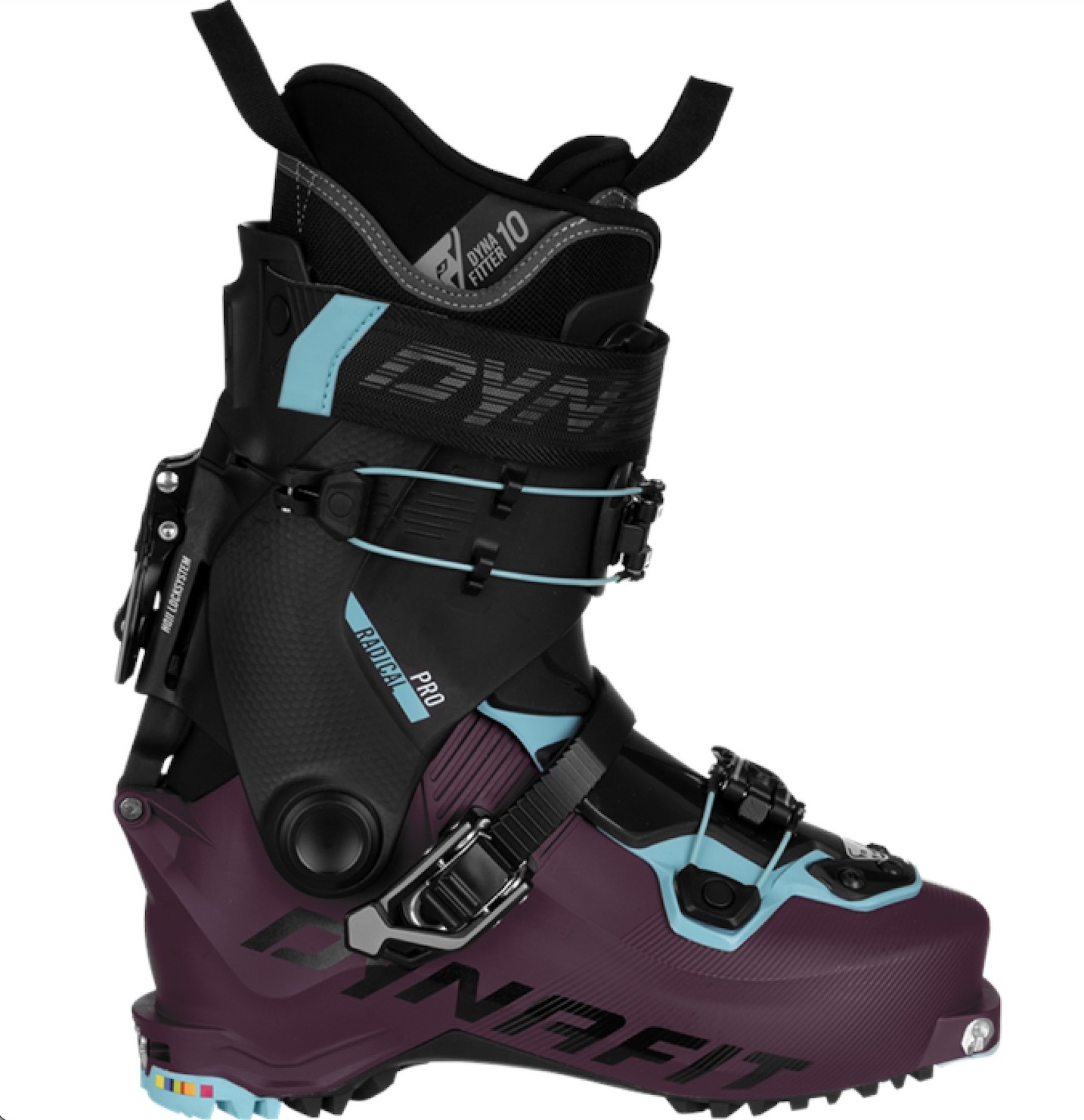 Last: 103.5mm (wide)
Last: 103.5mm (wide)
Flex: 110 (advanced/expert skiers)
Other flex: 100 (non-Pro version)
Weight (per boot): 1270g
Walk mode?: Yes
What we like: Hard-charging on the down without compromising much on the uphill.
What we don’t: Stock liners aren't great.
Could it be?! A true backcountry freeride boot for women? Yes, that's right, Dynafit stepped up its game by making a women's version of their popular Radical Pro a few years back, and they just keep getting better. A favorite among guides and mountain professionals who want all-day comfort and downhill performance without compromise, the Radical Pro shines as a touring boot. This editor spent over 270 days across 2 years skiing and working in these boots in Idaho, Washington, and Patagonia and still would recommend them to you. Need more convincing? A 60-degree ROM on the up, a Dynafit Hoji Lock System to quicken up transitions, and a truly stiff 110 flex for the down make the Radical Pro one of the best boots out there. The super roomy 103.5-millimeter last makes room for the wider-footed without sacrificing performance like other wide boots. New for 2025, Dynafit is also offering a non-Pro Radical model at a less stiff 100 flex and a savings of $150.
While Dynafit dropped the Rad Pro down to 1270 grams for a size 24.5, it still is far from the lightest backcountry design available. However, we think the extra weight is worth the freeride performance and warmth in negative double-digit Fahrenheit temps. We found the main drawback of these boots to be the stock liner provided by Dynafit. It packs down faster than we'd like and wears through quickly in certain areas. The Hoji Lock System is also advertised to be a single-lever transition, but we—along with other testers—found it easier to lock down the heel if you open the top buckle, transition the Hoji Lock, then close the top buckle—not a major setback, but something to note. All in all, this boot is meant for the backcountry aficionado who loves the down just as much as the up and doesn't mind a little extra training weight.
See the Dynafit Radical Pro See the Dynafit Radical
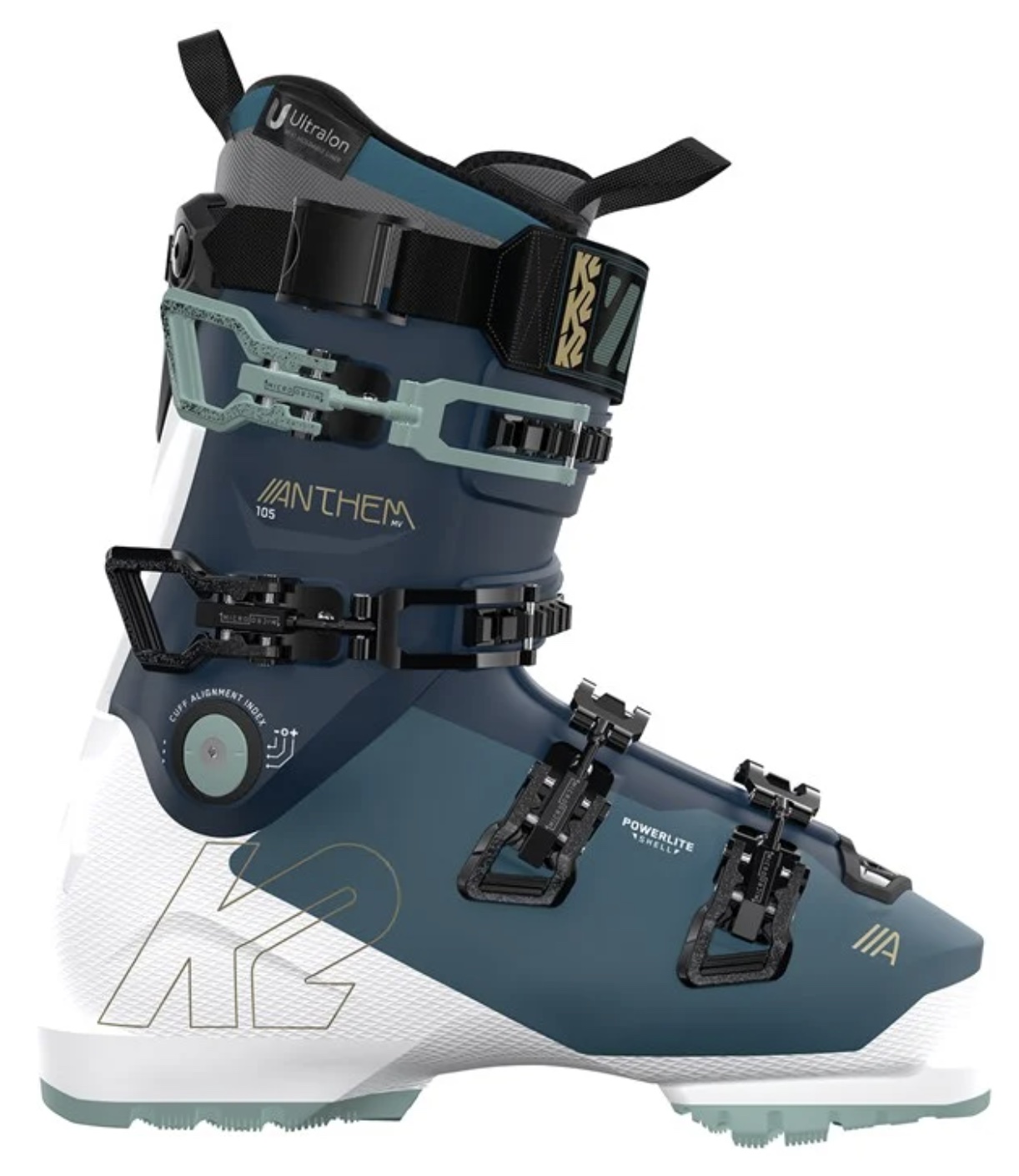 Last: 100mm (MV) or 98mm (LV)
Last: 100mm (MV) or 98mm (LV)
Flex: 105 (intermediate/advanced skiers)
Other flexes: 85, 115, 125
Weight (per boot): 1656g
Walk mode?: No
What we like: Great balance of performance and comfort.
What we don’t: We wish it had a walk mode function.
Lightweight and snappy, K2’s Anthem 105 is a responsive all-mountain boot that’s ideal for women who like to charge hard both on- and off-piste. With a moderately stiff 105 flex, it edges more toward precise than playful, but thankfully K2 didn’t skimp on comfort: Both the liner and shell can be heat molded, the boot comes in two widths (100mm MV or 98mm LV), and the rear cuff can be adjusted to accommodate different calf shapes. We wish that K2 had included a walk lever to add to the boot’s all-mountain versatility—a logical fit in our minds given its lightweight construction—but otherwise, there’s little to nitpick with the well-rounded design.
Despite the boot’s moderate stiffness, the K2 Anthem 105 is easy to take on and off thanks to softer material at the instep and oversized buckles that are easy to manipulate with gloved hands. We also found that it felt more lively and powerful on the slopes than the flex would suggest. That said, expert skiers who are blasting all over the mountain at top speed will likely want to step up to the stiffer Anthem 115 or 125, which have adjustable lasts. But for a hard-to-beat balance of performance and comfort at a good value, we really like the Anthem 105. K2 extended the Anthem collection to include a few BOA dial-equipped models last year for an extra $100 compared to the standard boots. We still prefer the simplicity and value of the original four-buckle Anthem 105, but those who like a more fine-tuned fit will appreciate these new additions.
See the K2 Anthem 105 MV See the K2 Anthem 125 BOA
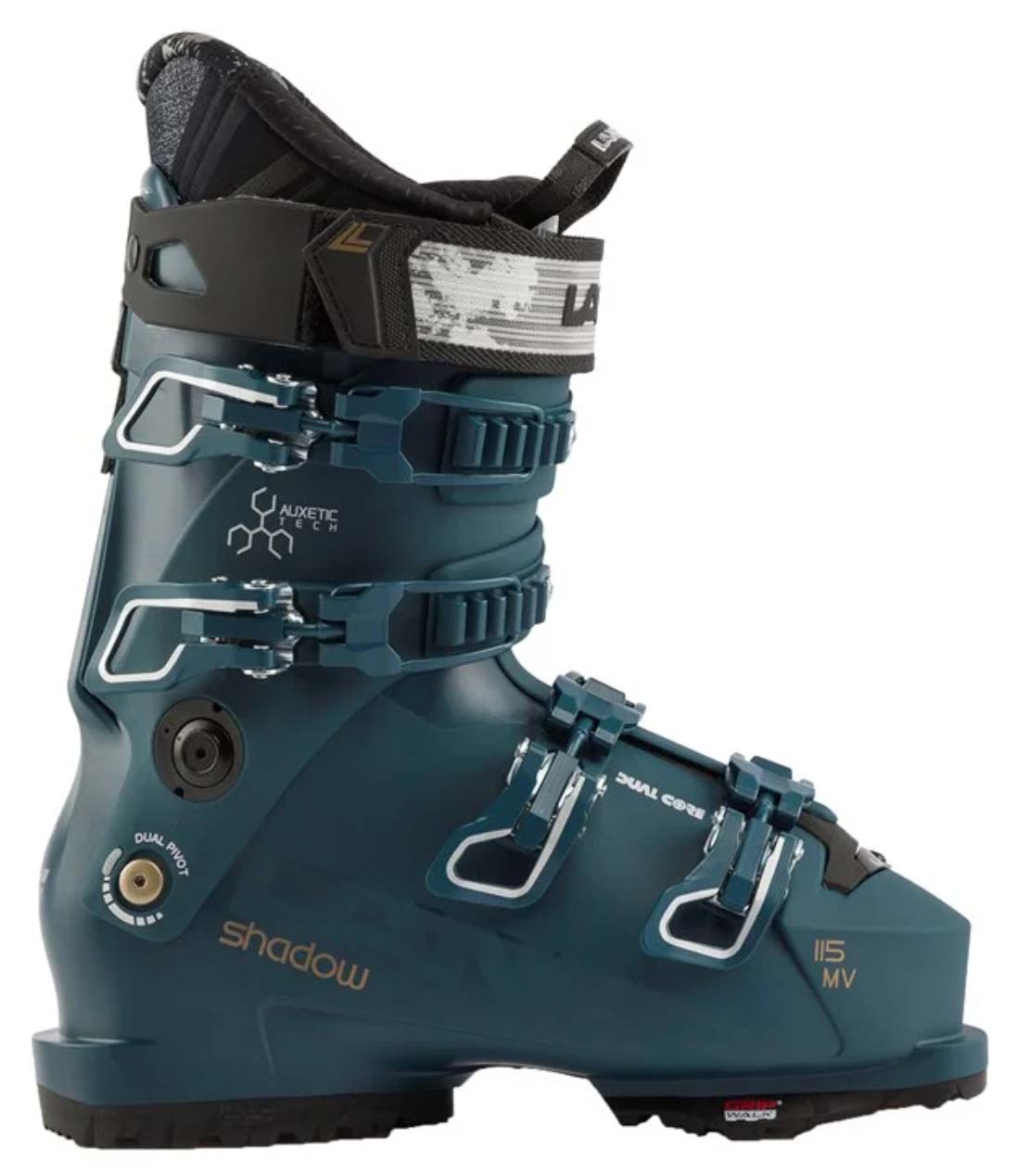 Last: 100mm (MV) or 97mm (LV)
Last: 100mm (MV) or 97mm (LV)
Flex: 115 (advanced/expert skiers)
Other flexes: 85, 95
Weight (per boot): 1775g
Walk mode?: No
What we like: An intriguing design that takes boot flex and efficient power transfer to a new level.
What we don’t: New technology takes some adjusting to; not as tried-and-true as XT3 above.
Released last season, Lange brought a unique and innovative approach to ski boot design with its Shadow line, most notably their Suspension Blade and Dual Pivot concepts. For context, traditional ski boots are built with two overlapping pieces (the cuff and the shell), which are attached via a spine along the back. With the Shadow, Lange places a “Suspension Blade”—a vertical bar that’s shorter and positioned higher than a traditional spine—that connects the cuff to the lower shell via two pivot points on either side of the heel. In theory, this allows the skier to transfer power more efficiently from their legs to their skis, thus saving energy while maintaining power and control. We found this made initiating a turn very easy, though if you're used to driving hard into your turns to get your skis on edge, it may take some time to adjust to the new technology's balance point.
Aside from the intriguing innovations, the women’s Lange Shadow 115 is a feature-packed boot that deserves a spot on any advanced or expert skier’s shortlist. With a 115 flex, it’s almost as stiff as ski boots get for ladies, and Lange didn’t skimp on comfort with a heat-moldable, single-piece liner that boasts an asymmetrical toe box to match the shape of the foot while minimizing pressure points. In addition, the women’s-specific cuff and shell boost comfort while making the boot easier to get on and off. Our only real hesitation is that the Shadow is still very new and unproven in the market, but all signs point to it being a hit. A final note: Beginner and intermediate riders will be better off with the softer 85- or 95-flex models, and the entire line is available in both LV (97mm) or MV (100mm) variations depending on your foot shape.
See the Lange Shadow 115 MV See the Lange Shadow 115 LV
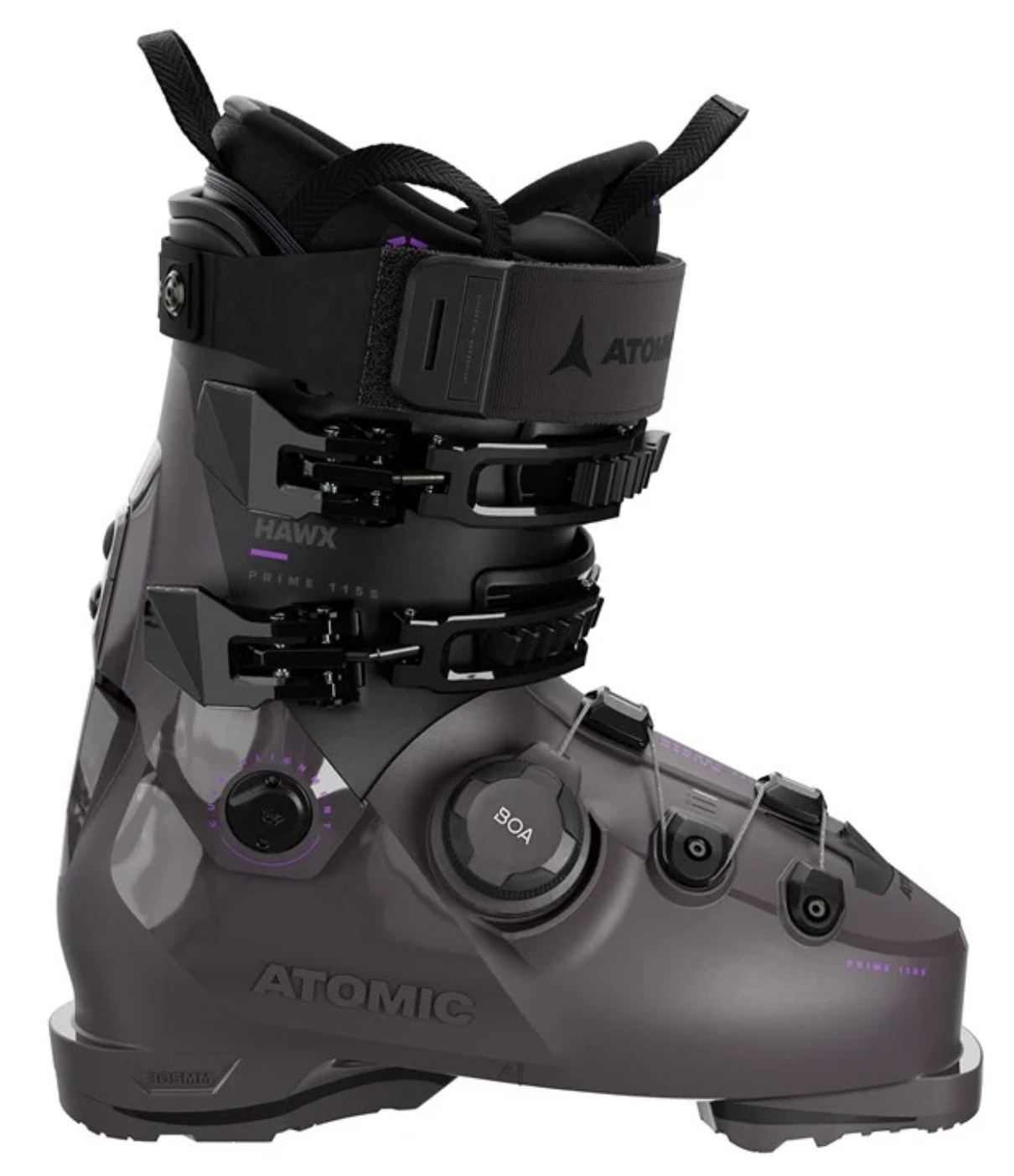 Last: 100mm
Last: 100mm
Flex: 115 (advanced/expert skiers)
Other flexes: 85, 95, 105 (beginner to advanced skiers)
Weight (per boot): 1739g
Walk mode?: No
What we like: A killer resort boot with a customizable fit.
What we don’t: Won't work for high-volume feet.
Far from a newcomer to performance and comfort, the Atomic Hawx Prime 115 is back this year with a new BOA closure system. The BOA dial adds additional customization to an already high-comfort boot with its memory fit liner, adaptive fit cuff system, and 3M Thinsulate insulation to keep your toes toasty even in sub-zero temps. The adaptive cuff comes with a removable spoiler, similar to the Lange XT3 Free 115 above, to allow comfort for a wider range of calves. And Atomic's coveted Prolite shell material makes the design just as much about performance as comfort, and we found it to provide enough support in choppy conditions without being too stiff or uncomfortable. A long day on and off groomers with no foot pain or cold toes? Sign us up.
While the Hawx Prime 115 skis pretty stiff, Atomic made space for those who want the same comfort and need a slightly softer boot for performance. The Prime is offered in an 85 flex and 95 flex, both with and without a BOA dial (the upgraded closure will run you $100 more than the standard version), along with a 105-flex BOA model. Having this many flex options is great, but it's a bummer to us that these boots aren't offered in more volume options. Excelling in the medium-volume arena, we'd love to see a high- and low-volume version of the Hawx Prime in the coming seasons to provide more options to skiers.
See the Atomic Hawx Prime 115 S BOA W See the Atomic Hawx Prime 85 W GW
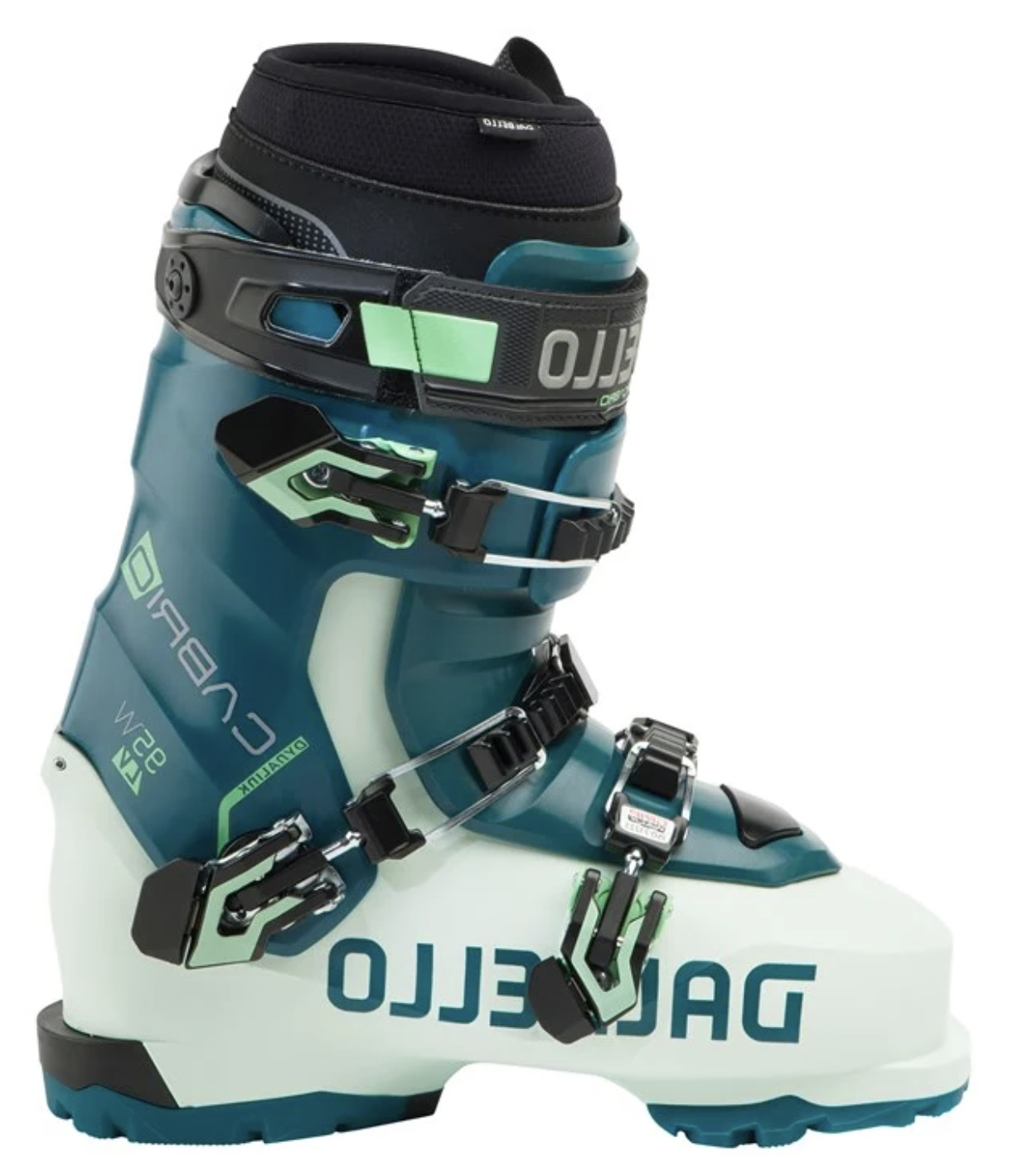 Last: 99mm
Last: 99mm
Flex: 95 (intermediate/advanced skiers)
Other flexes: 85, 115
Weight (per boot): 1730g
Walk mode?: No
What we like: An innovative freeride design that prioritizes off-piste performance without sacrificing comfort.
What we don’t: Not the best match for those who stick to groomers.
With a similar concept to the Lange Shadow above, Dalbello’s Cabrio series targets skiers who like to get creative and push their limits off-piste. The innovative design incorporates a three-piece shell (cuff, lower shell, and tongue) instead of the traditional two-piece (cuff and shell) setup. And rather than attaching the pieces via a spine and one or two rivets at the back, the Cabrio’s cuff secures to the shell using pivot points on both sides of the ankle (similar to Lange’s Dual Pivot technology), which helps promote a smooth and progressive flex. And thankfully, Dalbello didn’t skimp on comfort: The polyurethane shell is easy to mold, punch, and grind, and the Cabrio incorporates a new liner with three layers of foam—softer foam around the foot for comfort, denser foam sandwiched in the middle for structure, and a stiff outer layer to enhance power transmission. Finally, the removable cuff allows for extra room (or less height) at the top to accommodate varying calf shapes.
Although the Dalbello Cabrio is categorized as a low-volume boot, its moderate 99-millimeter last and customization capabilities make it a good option for everyone from narrow- to average-footed skiers. However, those with wide feet will be better off with a roomier last like that found in the K2 BFC 95 (103mm) or Dynafit Radical Pro (103.5mm) listed above. Additionally, skiers who stick to the trails won’t be able to reap the full benefit of this freeride boot—if you spend a lot of time on groomers, the more precise and powerful Tecnica Mach1 LV 115 above is a better match. But for freeriders who prefer to take the road less traveled, the Cabrio LV 95 is an approachable boot that offers true all-mountain performance while remaining comfortable from first chair to après.
See the Dalbello Cabrio LV 95 W
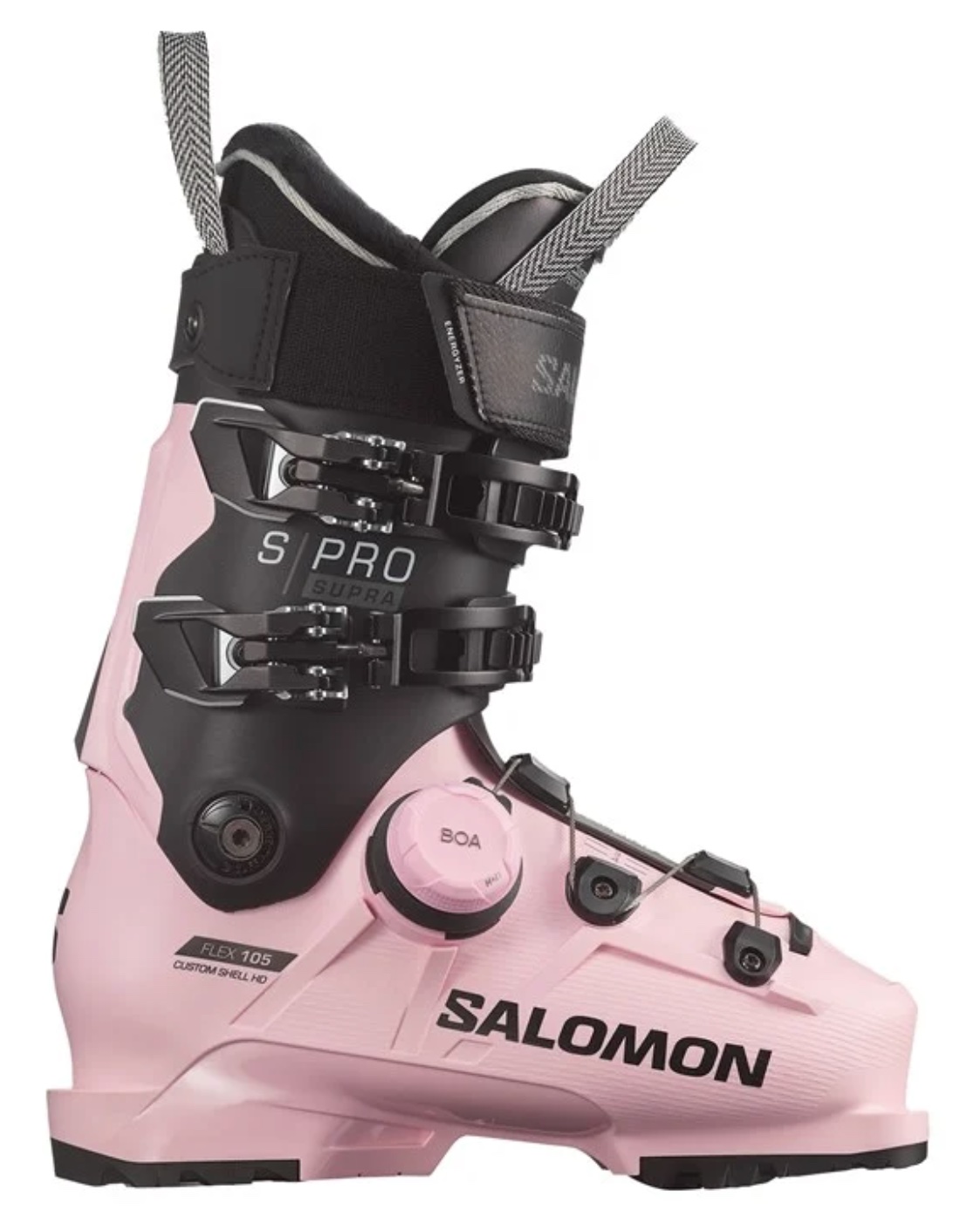 Last: 100mm
Last: 100mm
Flex: 105 (intermediate/advanced skiers)
Other flexes: None
Weight (per boot): 1600g
Walk mode?: No
What we like: One of the most customizable boots for those with irregular feet.
What we don’t: We wish there were more flex options.
While ski boots will never feel as comfy as a pair of Sorels, the Salomon S/Pro Supra BOA 105 is a beacon of light for those with irregular and hard-to-fit feet. Highly adjustable and customizable, the latest Custom Shell HD technology uses a thinner wall and a new mix of materials—including SensiMesh—to make them even easier to mold to all the intricacies of your anatomy while allowing your foot to be closer to the shell itself, delivering improved power transfer. We also found the heel to lock in our feet really well, doing away with the nagging heel-lift issue more than other boots. The beefy BOA closure, along with the thinner shell, allows this boot to truly dial into a custom fit and hug your foot in the best way possible. Even for a 105 flex, these ski just about as stiff—or even a little more than—advertised.
While the BOA dial is a plus for customizable fit, anyone who's used BOAs before knows that they come with the risk of breaking after extensive use. BOA does offer a lifetime guarantee on their products to help alleviate this, but it's something to keep in mind if you're planning on taking the boots on far-off adventures. And while the thinner shell makes the S/Pro Supra one of the most customizable options on the market, the verdict is still out on whether the reduction in wall material will detract from overall longevity or warmth in very cold environments. These are all important points to consider, but if you're the person with the funky feet—always a hotspot here, a bone spur there, an odd-shaped toe that no other boot or punching works for—the S/Pro is certainly worth considering.
See the Salomon S/Pro Supra BOA 105
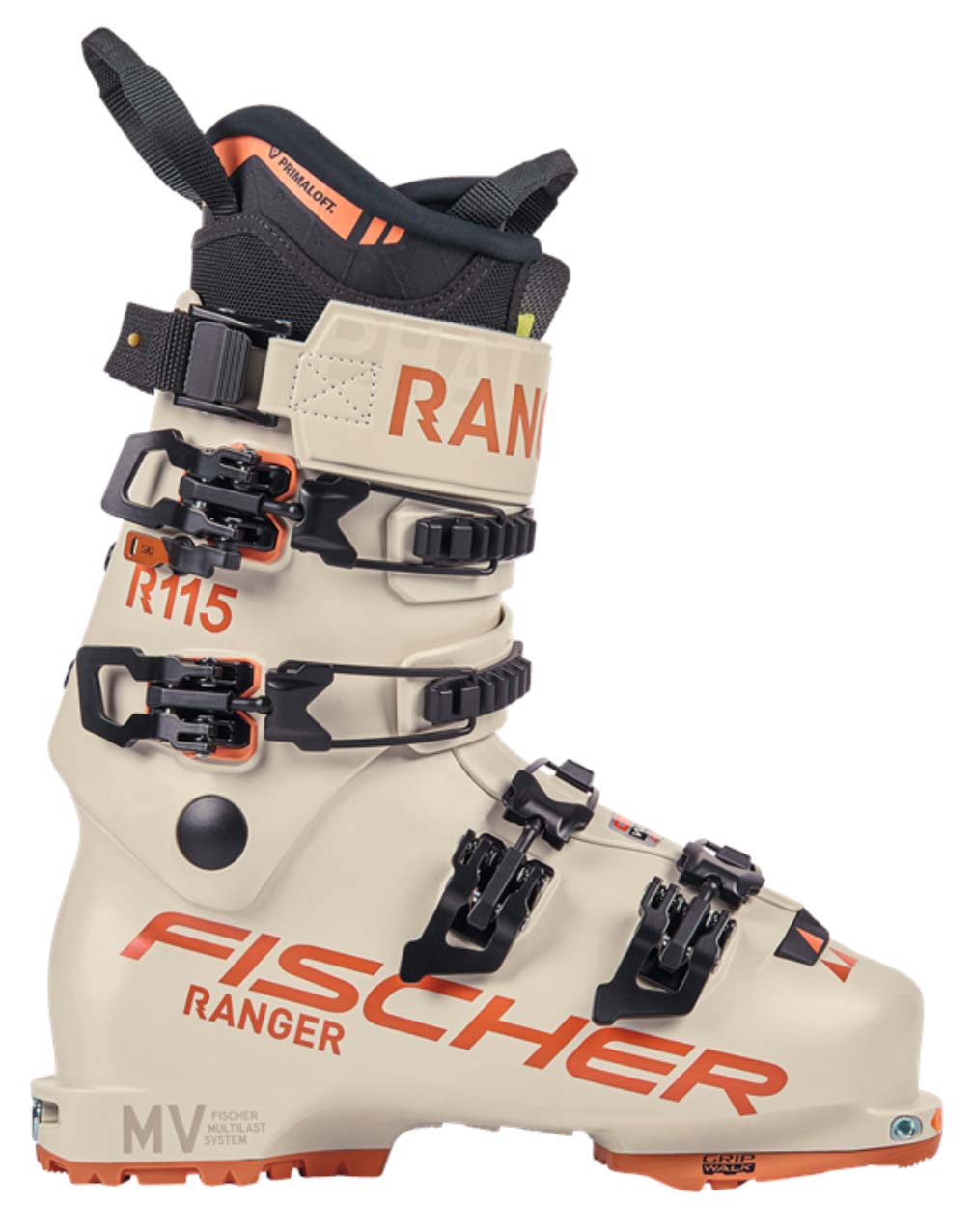 Last: 99mm
Last: 99mm
Flex: 115 (advanced/expert skiers)
Other flexes: 105, 110, 120
Weight (per boot): 1790g
Walk mode?: Yes
What we like: Rock-solid handling with touring capabilities.
What we don’t: On the heavy and stiff side for uphill travel.
Sharing a name with its hard-charging ski sibling, the Fischer Ranger 115 DYN is ready to rip on both sides of the rope. With a real-deal 115 flex, this boot offers the level of stiffness that aggressive all-mountain skiers need to lay down high-speed turns on groomers and blast through off-piste chop. Meanwhile, the 99-millimeter last isn’t prohibitively narrow and provides sufficient room to accommodate most average feet. Add GripWalk soles, an easy-to-operate walk mode lever on the cuff, decent range of motion, and tech binding compatibility, and the net result is a boot that’s ready to shred both in and out of bounds.
Like the Tecnica Cochise 95 W DYN (our previous pick for a hybrid boot before the Scarpa 4-Quattro XT above unseated it), the Fischer Ranger 115 DYN is too heavy to be a daily alpine touring companion. In addition, the Ranger requires additional break-in time out of the box compared to other options. It's noticeably stiff, making it a little harder to handle and control in sketchy and new-to-you areas in the backcountry. All that said, if you’re a strong and experienced rider who doesn’t mind a less forgiving feel, the Ranger 115 DYN won’t disappoint.
See the Fischer Ranger 115 DYN
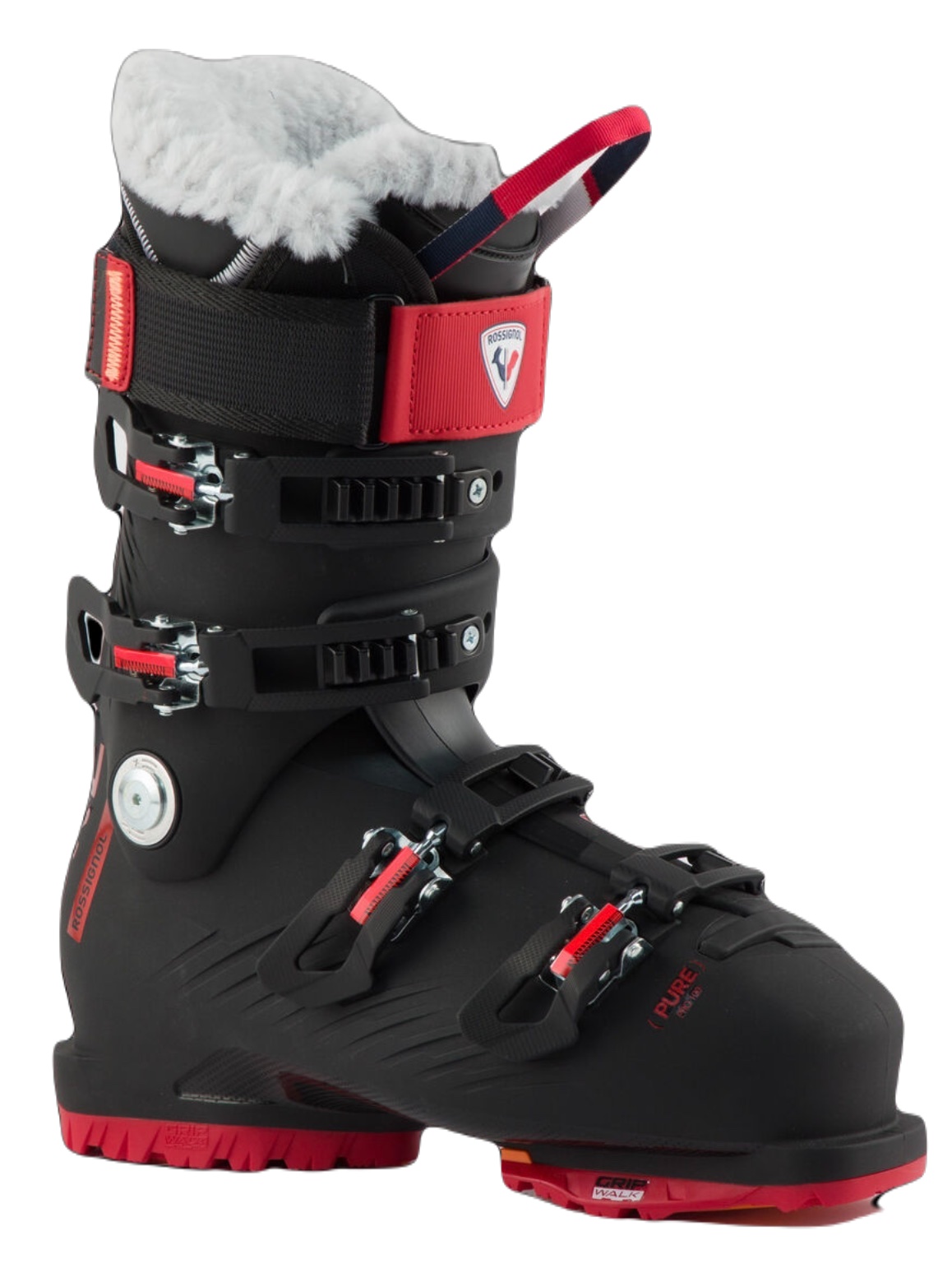 Last: 100mm
Last: 100mm
Flex: 100 (intermediate/advanced skiers)
Other flexes: 80, 90
Weight (per boot): 1670g
Walk mode?: No
What we like: It’ll keep your feet warm from the first chair to the last.
What we don’t: Relatively pricey and overbuilt for mild conditions.
The Ross Pure Pro is the perfect companion for an upscale ski vacation to Aspen's slopes: plush, fancily warm, and delivering all the goods. It’s rare that a boot actually outperforms its marketing copy, but that’s exactly what we found with the Pure Pro 100 GW. Not only does this boot ski stiffer than its 100 flex would suggest, but its “on piste” designation sells its capabilities short—we found off-trail performance to be competitive with most of the all-mountain competition. Part of this can be credited to the boot’s unique adjustable flex, which allows you to soften or stiffen the feel to customize power and overall performance (you can go up or down by a rating of 5). The rest of the design is equally well sorted, including a fully customizable liner and asymmetric cuff with a mix of soft and hard plastics to maximize support while keeping weight in check. For skiers who really like to geek out on their setup, this level of customization is a real boon.
In addition to its innovative adjustable flex, another feature unique to the Rossignol Pure Pro 100 is its thick merino wool insulation. Along with giving the boot a noticeably soft and plush feel, it also adds a sizable dose of warmth on frigid resort days. Rossignol also sells an upgraded Pure Pro Heat model with a built-in heated liner for an additional $100, although both boots will likely be overkill for those who run warm, like to push their limits, or venture into the sidecountry frequently. Given the thick wool lining, the Pure Pro is also less year-round-friendly than many of its competitors, which is certainly worth considering if you like to get out into late spring. Finally, the Rossignol is fairly pricey at $700 given the lack of versatility, but there’s no denying the boots’ premium warmth and impressive customization.
See the Rossignol Pure Pro 100 GW
| Boot | Price | Last | Flex | Weight (per boot) | Walk Mode? |
|---|---|---|---|---|---|
| Nordica Promachine 105 W | $700 | 98mm | 105 (intermediate/advanced) | 1810g | No |
| Dalbello Veloce Max 65 W | $250 | 103mm | 65 (beginner/intermediate) | 1730g | No |
| Tecnica Mach1 LV 115 W TD | $750 | 98 or 100mm | 115 (advanced/expert) | 1630g | No |
| K2 BFC 95 | $450 | 103mm | 95 (intermediate/advanced) | 1792g | No |
| Lange XT3 Free 115 LV | $750 | 97mm | 115 (advanced/expert) | 1614g | Yes |
| Scarpa 4-Quattro XT W | $869 | 100mm | 115 (advanced/expert) | 1345g | Yes |
| Tecnica Zero G Tour Pro W | $900 | 99mm | 125 (advanced/expert) | 1128g | Yes |
| Dynafit Radical Pro | $800 | 103.5mm | 110 (advanced/expert) | 1270g | Yes |
| K2 Anthem 105 MV | $600 | 100mm | 105 (intermediate/advanced) | 1656g | No |
| Lange Shadow 115 MV | $750 | 100mm | 115 (advanced/expert) | 1775g | No |
| Atomic Hawx Prime 115 S BOA | $750 | 100mm | 115 (advanced/expert) | 1739g | No |
| Dalbello Cabrio LV 95 W | $600 | 99mm | 95 (intermediate/advanced) | 1730g | No |
| Salomon S/Pro Supra BOA 105 | $700 | 100mm | 105 (intermediate/advanced) | 1600g | No |
| Fischer Ranger 115 DYN | $700 | 99mm | 115 (advanced/expert) | 1790g | Yes |
| Rossignol Pure Pro 100 GW | $700 | 100mm | 100 (intermediate/advanced) | 1670g | No |
Skiing is a favorite pastime among most of the editors at Switchback Travel. And while many have come a long way since our humble beginnings many decades ago, we pride ourselves on providing exceptional beginner and intermediate-specific feedback. Freelance writer and gear tester Alli Hartz kicked off this guide back in 2022 with a streamlined selection of options available specifically for women. Based in Bend, Oregon, Alli shares her love for skiing through teaching avalanche courses and ski guiding in the winter months. Contributing editor Brooke Maushund currently manages this guide. A lifelong lover of all things snow, Brooke has served as a ski patroller, guide, avalanche educator, observer, and avalanche forecaster in the snowpacks of Idaho, Patagonia, Washington, and the eastern Sierra.
Our current lineup of fifteen women's-specific boots above is the result of ongoing testing, feedback from our contributors, and extensive research. Given the rapidly growing amount of offerings for women's boots, we’ve included a relatively wide variety of options, varying in last, flex, and use case. To make our list, each boot had to stand out in one or more areas, with many striking an effective balance between performance and price. If you're looking to complete your setup for 2025, know we took a similar approach with our lineup of women's all-mountain skis and ski bindings.
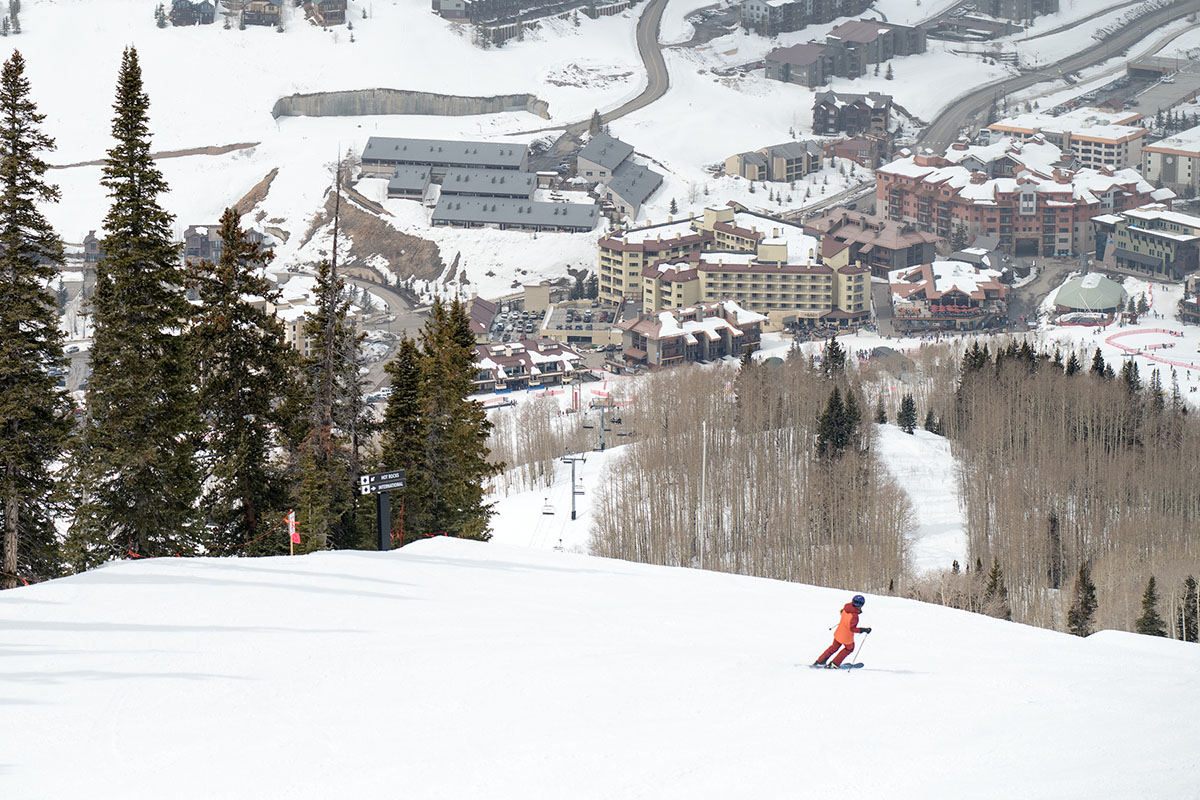
Most ski boots are technically unisex, but the majority of core manufacturers also make women’s-specific models. What makes a woman’s boot different? To start, they’re usually offered in smaller sizes compared to their unisex counterparts. For example, the women’s Nordica Promachine 105 TK is offered in Mondo sizes from 22.5 to 27.5, while the men’s/unisex Promachine 100 is available in 24 to 30.5. While this is great, a number of women's specific models are simply men's boots in a smaller size without many additional changes. Those that are designed in a more thoughtful manner are often shaped to better accommodate the female anatomy, including lower or adjustable cuffs to work with shorter and wider calves.
In addition, many women's-specific boots have lower flex ratings, generally making them slightly softer. This is rooted in the very early belief that women don't need stiffer boots due to ability, size, and aggressiveness of ski style—an argument that has been well disproven at this point. While the ski industry can acknowledge women need high-performance gear at the same level as men, the products are still catching up. There are many stiffer boots still only available in a unisex shape, though more and more stiff flex options are coming out in women-specific shapes. A good example is the new Tecnica Zero G Tour Pro, which took the long-time favorite aggressive men's boot and made a women's-specific version with a comparable flex of 125. A true breakthrough for 2025!
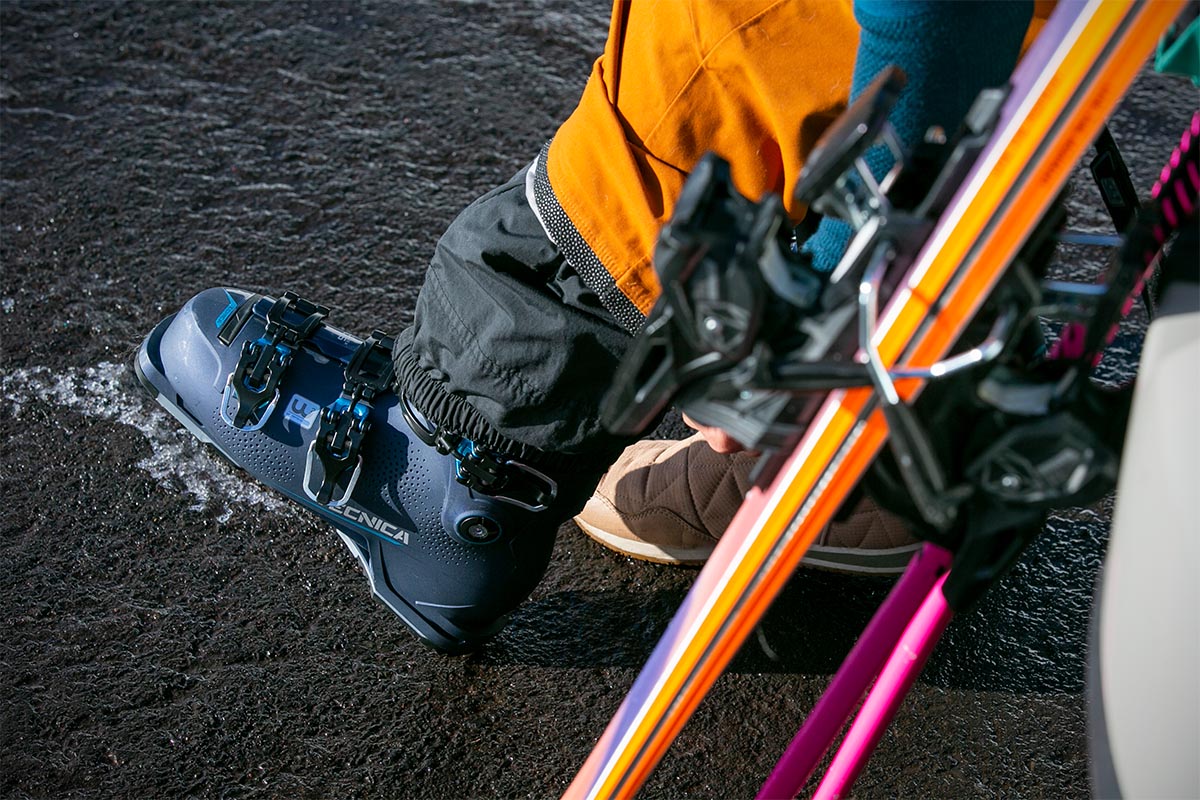
No two women are built the same, however, and a final decision should come down to what fits and feels best. If you identify as female but find that the men’s or unisex version of a boot fits you better than the women’s-specific model (or vice versa), it’s likely the better option for you. In the end, what’s most important is that your boots feel snug but comfortable and line up with your riding style and objectives. And while you're probably not reading this guide if you grew up racing, if you're skiing at that level on-piste, it'd be best to look into stiff race boots, not the recreational offerings here.
The women’s ski boot market is a big one, but starting your search by choosing the proper flex will quickly narrow it down. Most women’s downhill boots have a flex rating between 60 and 125. Lower numbers are generally softer, more forgiving, and more comfortable, which makes them ideal for beginners. We include a couple of our favorite beginner boots for women above—like the Dalbello Veloce Max 65 —but for a more complete breakdown, we’ve compiled a dedicated round-up of the best ski boots for beginners. Beginners should understand that although a softer flex in a downhill boot generally means it is for newer skiers, softer flex touring boots are not aimed at the same market. The women's Scarpa F1 LT is a great example here. With a 95 flex rating coming from a lightweight design to save weight on far-reaching backcountry pursuits, the F1 LT is not going to be a good match for a beginner to intermediate skier, while the downhill-specific K2 BFC 95 (same flex) would be perfect.
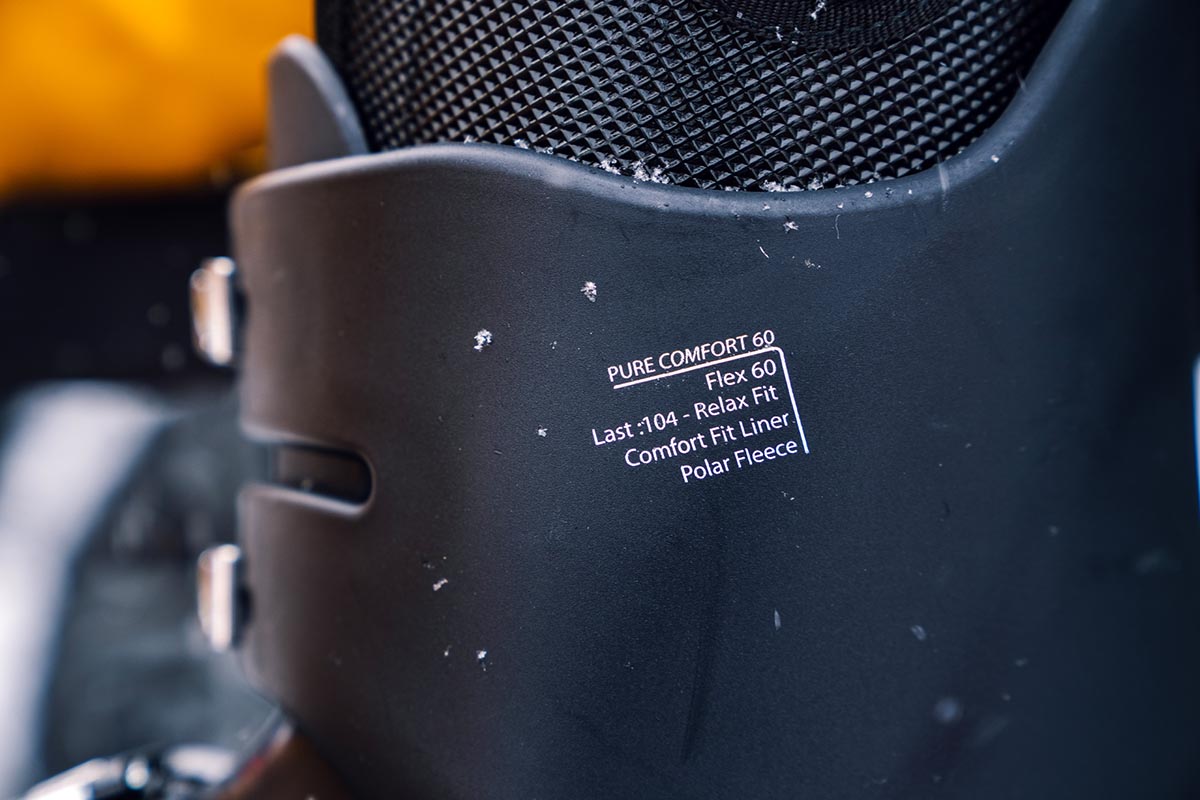
Moving up in stiffness to intermediate, advanced, and expert models gets you a boot that isn't as cushy but transfers your energy input more efficiently to your bindings and skis. As a result, you waste less energy flexing the boot forward and get a more instantaneous response. Additionally, a preferred stiffness also correlates with your body weight, with heavier and more powerful skiers needing to go with a higher number. Here are general recommendations for flex ratings based on skier level, but know that flexes are not standardized across brands, nor are all flexes created equal as we explained above:
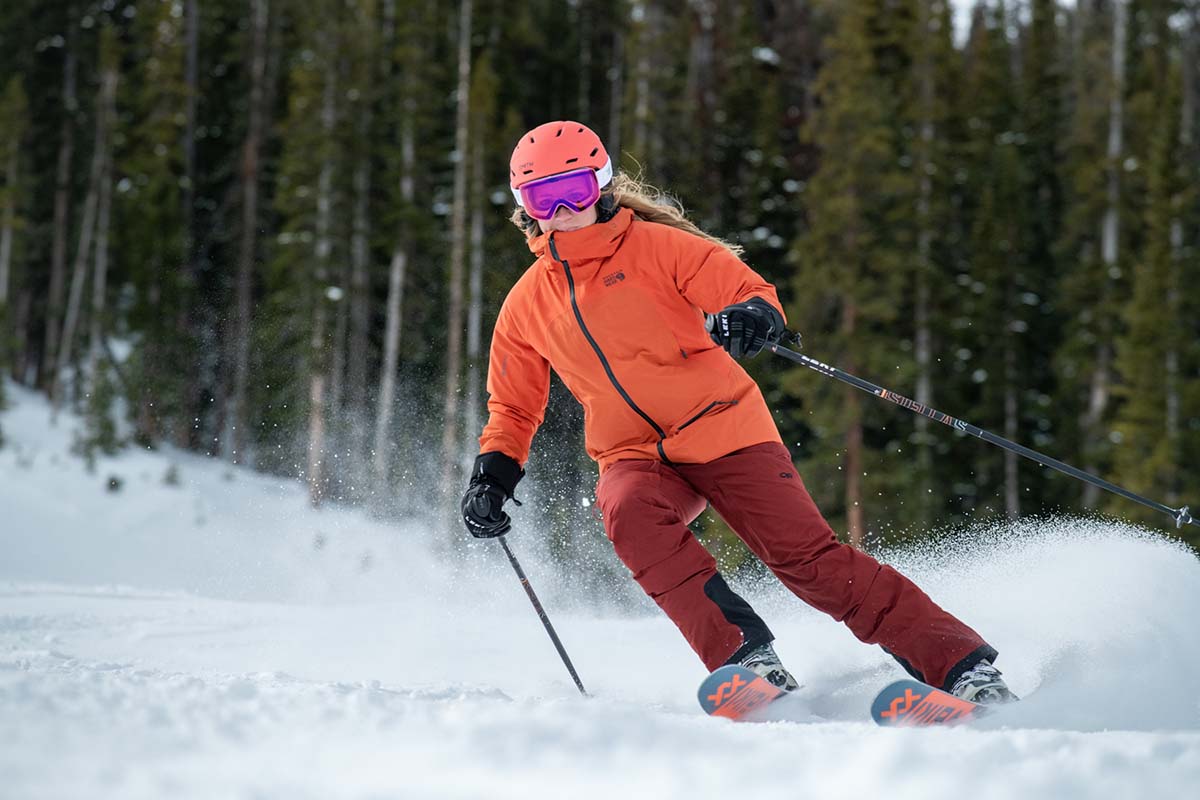
Ski boot sizing is one of the most difficult things to understand when shopping online. It’s not as simple as taking your shoe size and matching it to a Mondo size (ski boot sizing nomenclature) on a chart. The length, width, volume, and underfoot profile need to be dialed in for a boot to truly fit. As a result, we recommend going to a local shop to get sized. If this is not an option, find a reputable online retailer that allows for returns and plan to order a couple of sizes with the expectation that they probably won’t fit exactly as you may expect. For a good baseline level of knowledge, we break down the most common boot sizing terminology and considerations below.
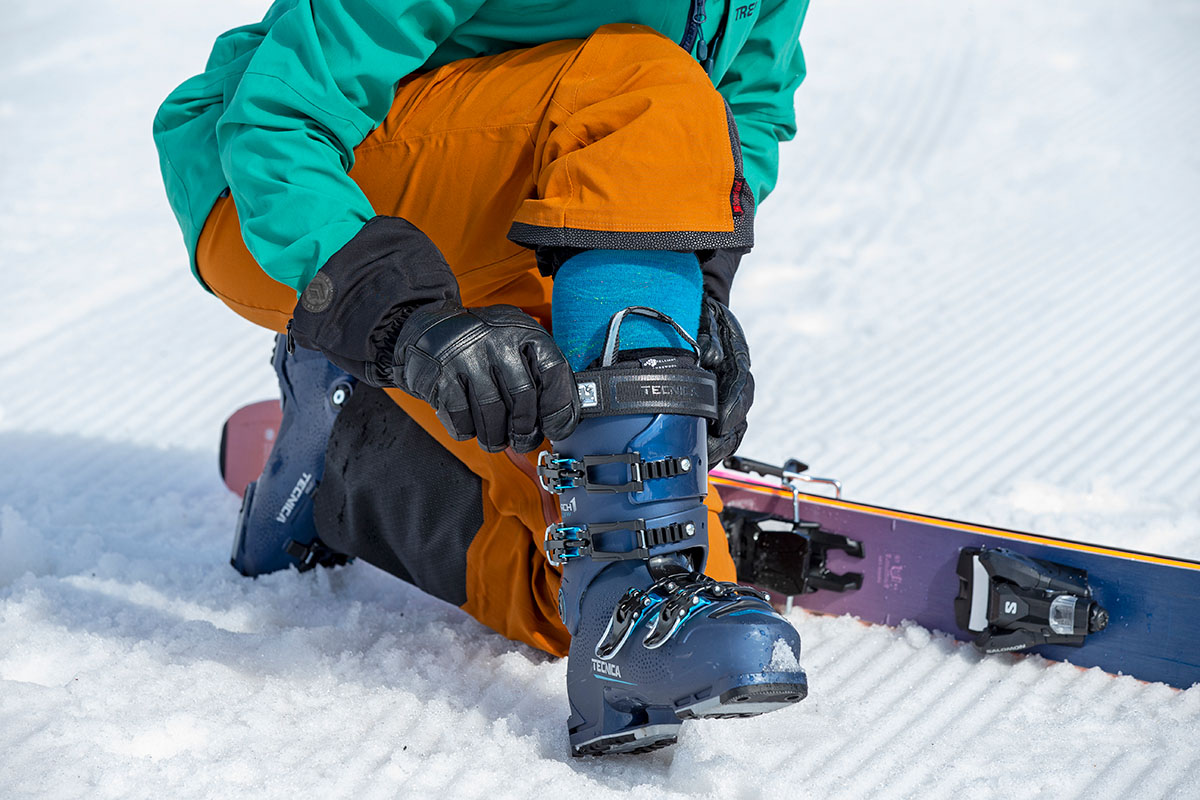
Mondo
Both men’s and women’s ski boots are listed in unisex Mondo (or Mondopoint) sizing: the length of your foot measured in centimeters. You can measure your foot by tracing its outline on a piece of paper or marking the bottom of the heel and top of the toes. If your foot measures 23 centimeters in length, your Mondo size is 23. Getting measured in a ski shop is preferred, but this is a rough way to do it at home.
Every manufacturer or retailer provides a sizing chart that matches shoe sizes to ski boot sizes, but your actual Mondo size may be a size or two smaller than what you see on the chart. This is because a tight fit is recommended with ski boots. Ski boot liners are made of foam and will mold to your feet over time, so it’s best to start with a snug fit and wear them in.
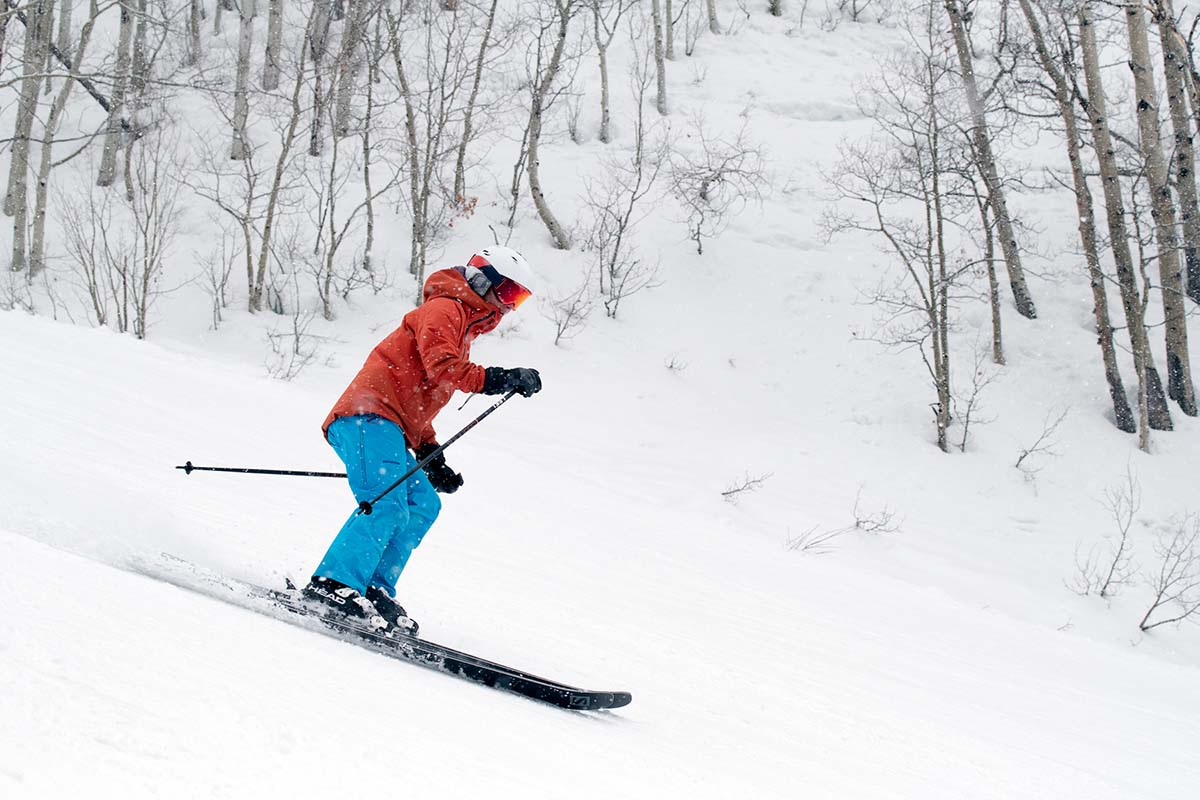
Last
Footbed width, referred to as last, is another important specification for ski boots. This measurement is based on the width of the forefoot and listed in millimeters. Most manufacturers make ski boots with varying lasts to accommodate those with narrow, average, and wide feet. And some models, including the Lange Shadow 115, are made with multiple last options (in this case, 97mm “LV” and 100mm “MV” variations). It’s important to get this part of the fit right because side-to-side motion is a given when descending a hill, and a boot that’s too loose around the sides of your feet will negatively affect performance.
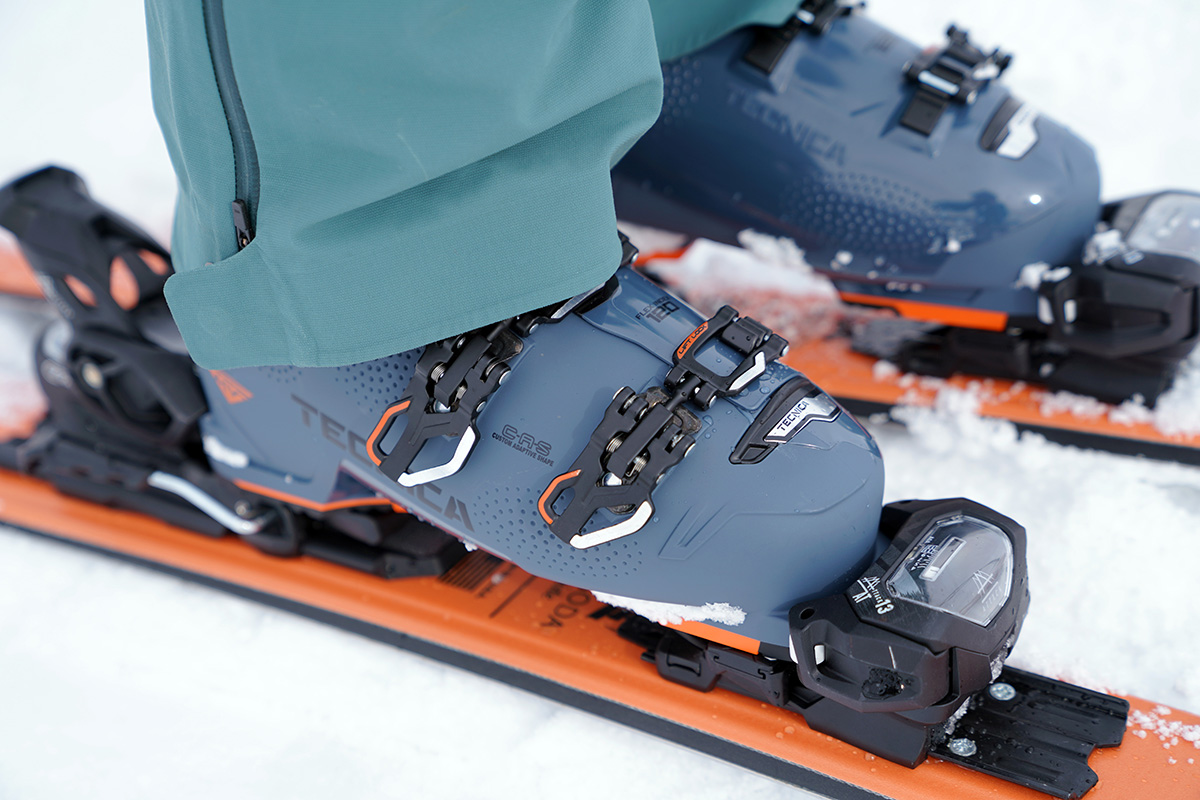
For those with narrow feet or looking for performance boots with a more precise fit, look in the 96- to 98-millimeter range. For reference, average lasts are around 99 to 100 millimeters for women. Those with particularly wide feet may have some challenges finding the right pair of boots, although there are a growing number of high-performance designs made in wider lasts, including the K2 BFC 95 at 103 millimeters. Another unique design is Dalbello's Panterra, which has the option to adjust the last width between 99 and 101 millimeters with its foremost buckle.
Replaceable Footbeds/Insoles
No matter how well you do in selecting the proper fit, you still may experience discomfort during a full day of skiing. That’s where another piece of the fit puzzle comes in: replaceable insoles. Most downhill ski boot liners have a removable insole, much like a hiking boot. Swapping these out for a quality aftermarket insole that better matches your foot profile can make a big difference. New insoles can provide better arch support, more or less volume, and a heel cup that better locks your foot in place. Good aftermarket insoles can be found from brands like Superfeet and SOLE.
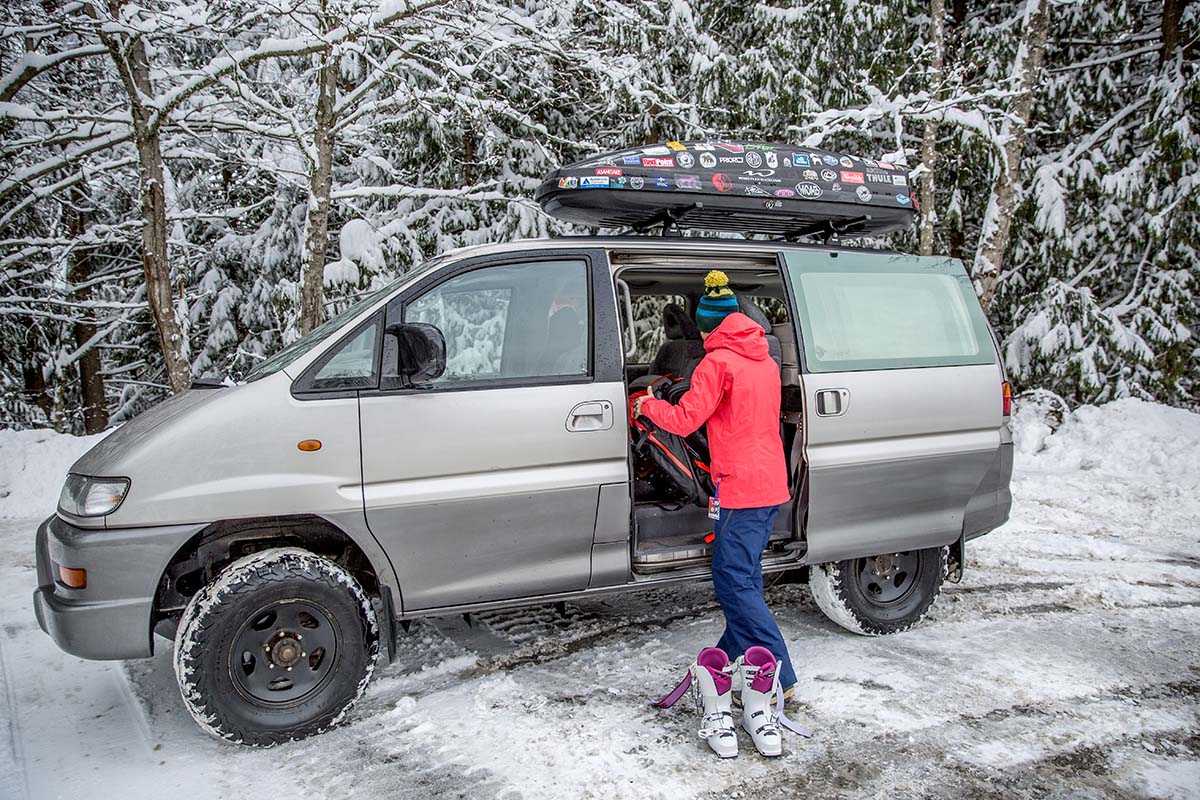
Another related alternative is getting a custom footbed from a boot fitter (which requires getting fit in person). This is an expensive process but can be worthwhile for those with hard-to-fit feet or who ski a lot each year. Most folks won't need to do this—it's often a last-ditch effort in finding a comfortable fit—but if you're low on options, it's worth checking with your local ski shop to see if they offer the service.
Most all-mountain ski boots consist of two independent pieces: A hard plastic outer shell that provides structure and strength and a removable liner that delivers comfort, support, and insulation. Liners are made with varying amounts of foam depending on the type of skiing the boot is intended for. Downhill racing boots, for instance, will have far less foam than beginner-friendly designs due to the focus on performance over all-day comfort. However, it’s not always as simple as choosing the plushest boot liner (beginners and comfort-oriented skiers are an exception). Softer foam won’t hold your foot and shin as well while carving, and it may not mold as well to your feet over time.
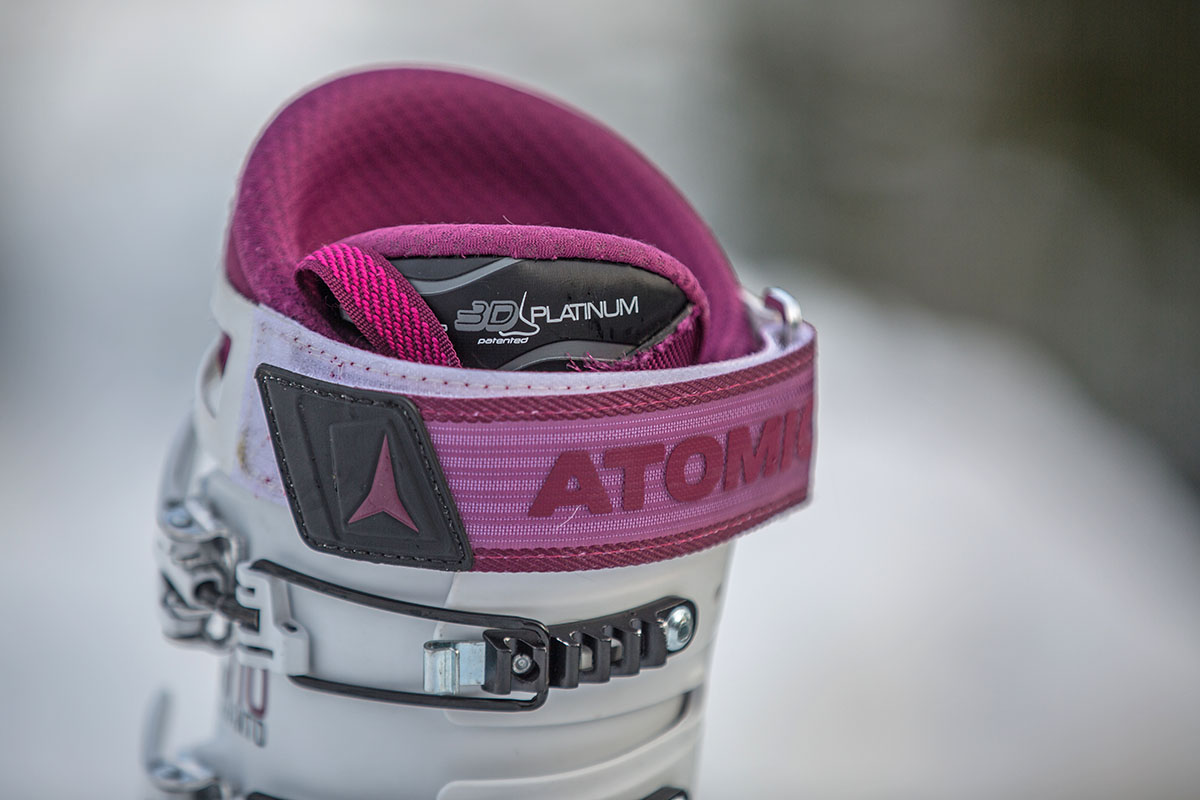
Supportive but comfortable is the preferred place to be for most intermediate and advanced skiers. As we mentioned above, your liner will conform to your feet, so don’t be too concerned if it feels snug at first. That said, make sure it’s not overly restricting and that your toes aren't smashed against the hard-sided shell, as painful boots and cold toes can quickly ruin a good ski day.
While picking the right boot make and model is essential, many of us will find ourselves with "hot spots" or places of irritation on our feet after a day of skiing. Sometimes these are just from general anatomy, or if you're like this author, you may have some funny bumps on your feet from years of distance trail running. Luckily, there are two ways to further customize the fit of your boots: heat-molding your liners and punching your boots.
Just about all ski boot liners these days are heat-moldable. While you can attempt the process at home, more than one ski bum has a story about catching their liners on fire in their oven. By heat molding at a local ski shop with a professional boot fitter (who has the required equipment), liners can be custom-fitted to your feet. This is a nice way to get the liner to fit your feet right out of the box, though it’s not necessary for many folks. You can get much of the same fitting accomplished just by wearing the liners around the house or on a few early-season ski days. But for those who don’t want to deal with a break-in period, it's a useful tool that helps dial in comfort quickly and effectively.
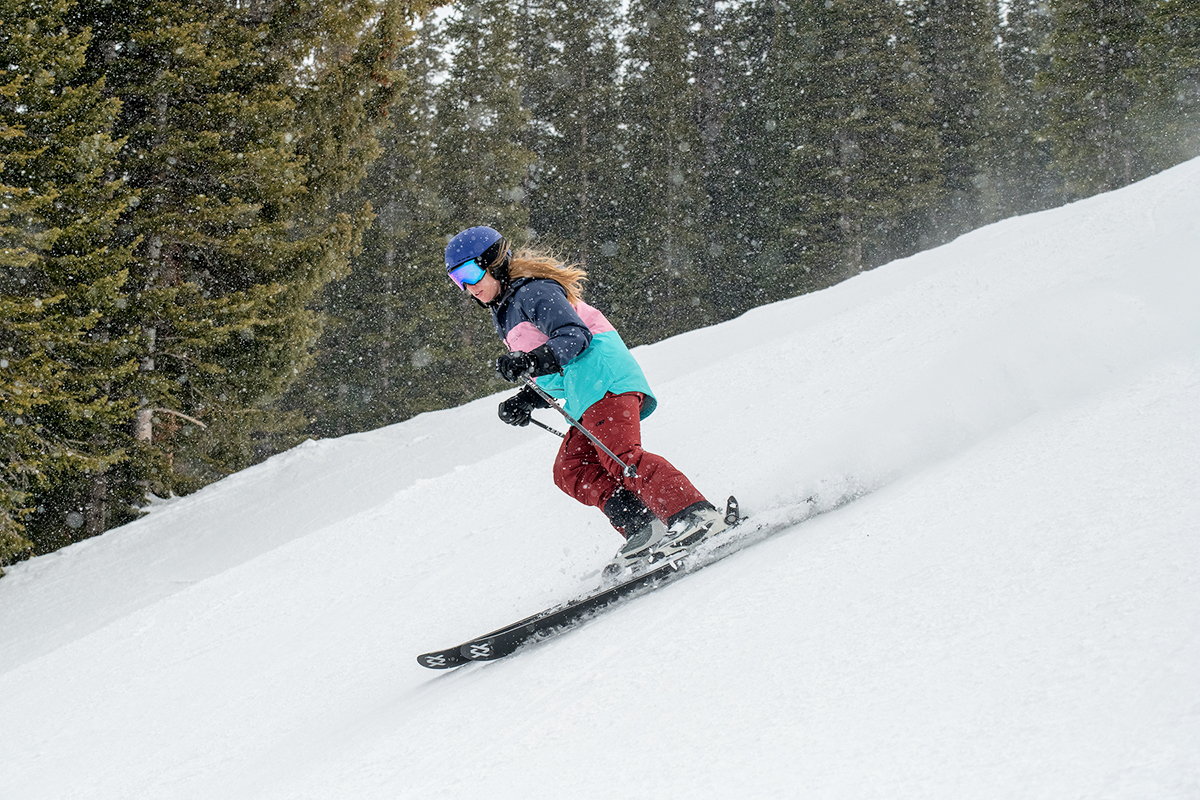
Some will still have painful, identifiable hot spots they can point to after a day of skiing, even with heat-molded liners. For those with some irregular bumps, making a full-service appointment with a trusted local boot fitter for some punching may be the best solution. Boot fitters work with you to identify your hot spots and "punch" your boot shells to create more room for any irregularities. To punch a ski boot shell, fitters will take a heating device (typically a heat gun) and heat the plastic until it's malleable. They'll press out on the shell to create move volume just where you need it, have you try on the boot again, and continue this process until you no longer have any issues. If this sounds complex, it's because it is—be sure to go to a professional to avoid damaging your shells by trying this at home.
To start, it’s helpful to know that buckles and strap designs do not vary greatly between brands. The buckle systems on most downhill ski boots follow a similar methodology: two buckles across the foot, one just above the ankle, and another along the shin. Look for buckles made mostly with aluminum for greater durability (plastic is cheaper but a bit more prone to breaking, especially in very cold temperatures). Some boots try and cut some weight by removing the buckle at the ankle, but for downhill purposes when total boot weight isn’t as important, we find it well worth having the more supportive four-aluminum-buckle design.
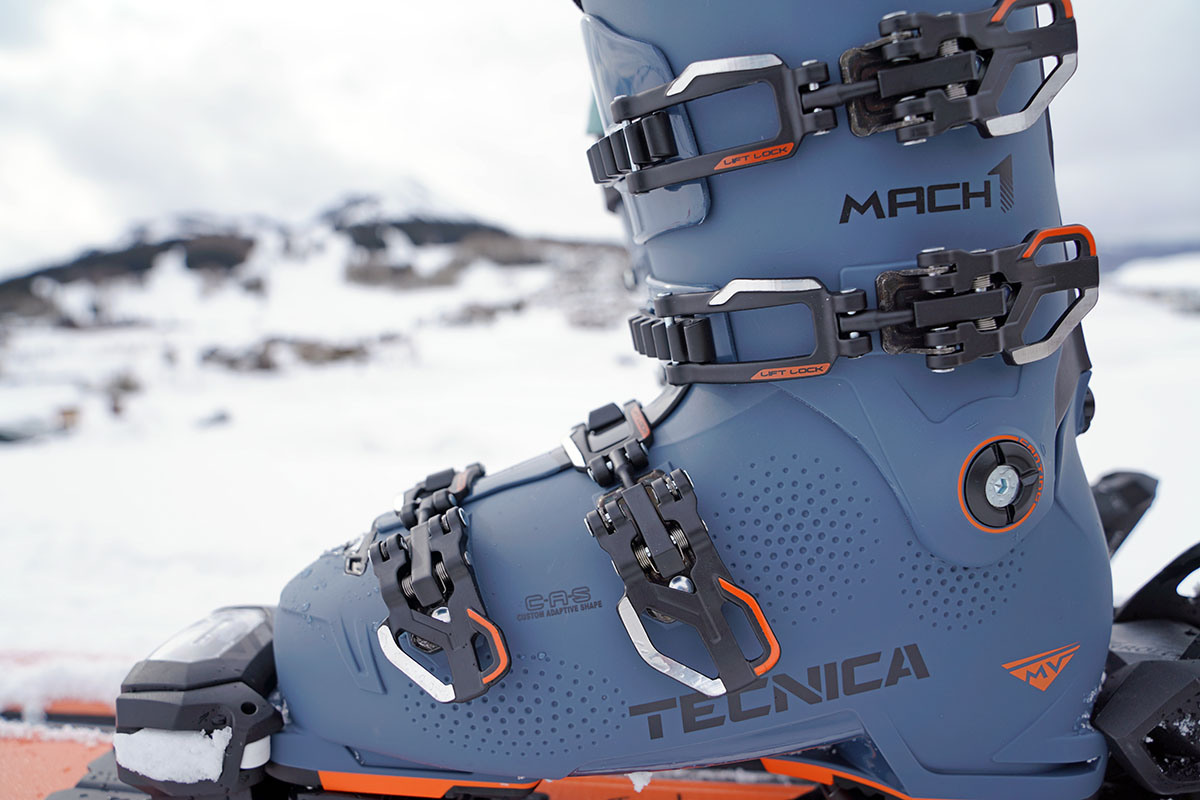
Another important piece of the design is the strap at the top of the boot near the cuff. Sometimes referred to as the "power strap," it keeps that top portion nicely locked into place to help bring out the full performance potential of your boots. Four buckles, as well as a quality power strap, help dial in your fit with macro and micro adjustments, which makes accommodating a variety of leg shapes and sizes that much easier.
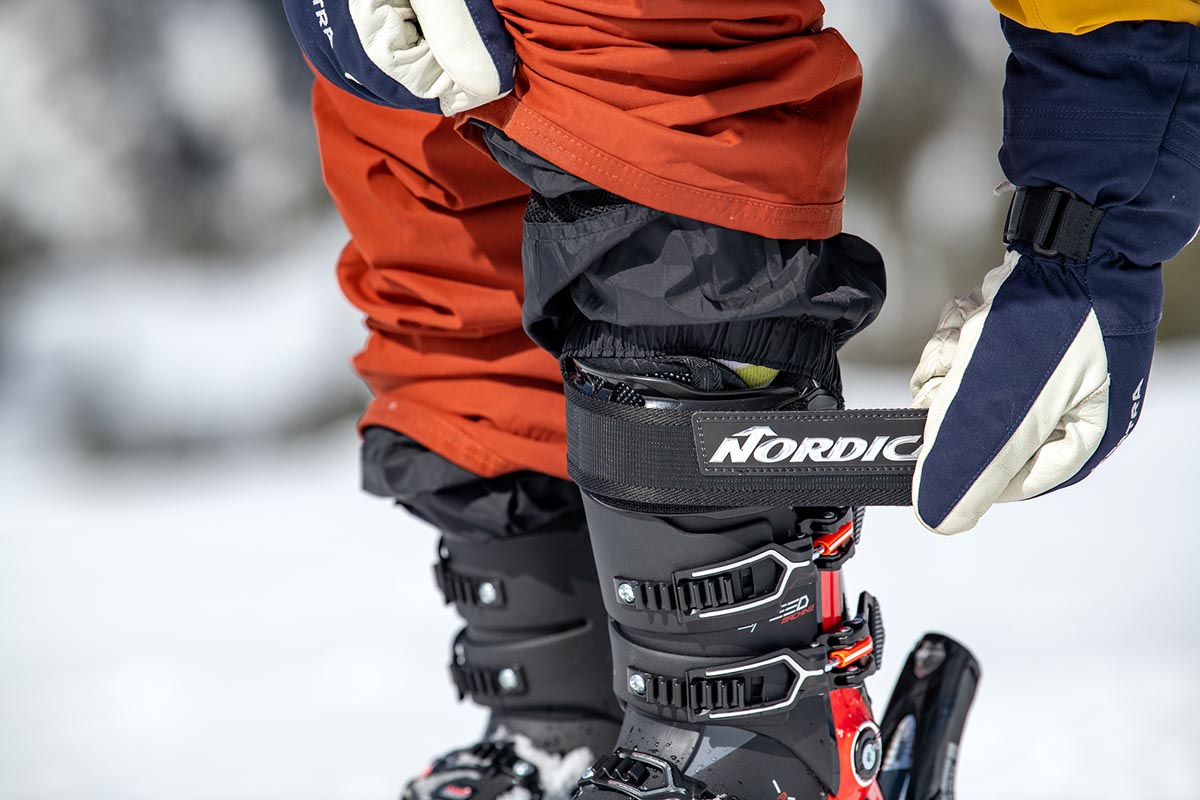
BOA dials offer ultimate fit customization and are becoming common on outdoor footwear of all types. The concept is fairly simple: A thin cable is routed throughout the boot, and twisting the dial adjusts the tension of the cable in small increments to achieve a snug and even all-around fit (note that some designs boast two dials). When you're done, simply pull out the dial to release the tension. The BOA system’s primary advantage is that it allows you to achieve a noticeably more precise fit than traditional buckles. It’s also a clean design that keeps bulk to a minimum, which may or may not be a factor depending on your intended use(s). K2 and Vans were early adopters of the technology, but today, you’ll find BOA dials on footwear designed for cycling, golf, mountaineering, hiking, snowboarding, and, of course, skiing.
All that said, BOA dials are not without fault. First, BOA-equipped models generally cost more than comparable designs without the tech—K2’s Anthem 105 BOA, for example, costs $100 more than the standard, four-buckle Anthem 105. Second, the BOA system comprises more moving parts than standard laces or buckles, which translates to more potential failure points over time. Depending on the design, a broken cable or dial could render your shoe or boot temporarily useless. The good news is that BOA offers free repair kits, and you can purchase spare parts relatively cheaply if you’re concerned about issues in the field. In our experience, BOA dials are highly reliable and great for maximizing fit customization, but whether or not the tech is worth the added cost—and potential time investment—is up to you.
Shifting to the bottom of the boots, downhill ski boot soles fall into two categories: traditional ISO 5355 models and newer, GripWalk-equipped designs. Starting with the former, ISO 5355-compatible boots are mostly flat underfoot and sized to fit and release from the toe piece on a traditional alpine binding. The main downside is that they’re uncomfortable and awkward when you’re walking around without skis on or hiking up a bootpack—their shape and simple outsoles lead to an awkward gait and can be quite slippery on anything from hardpack snow and ice to slick bathroom floors.
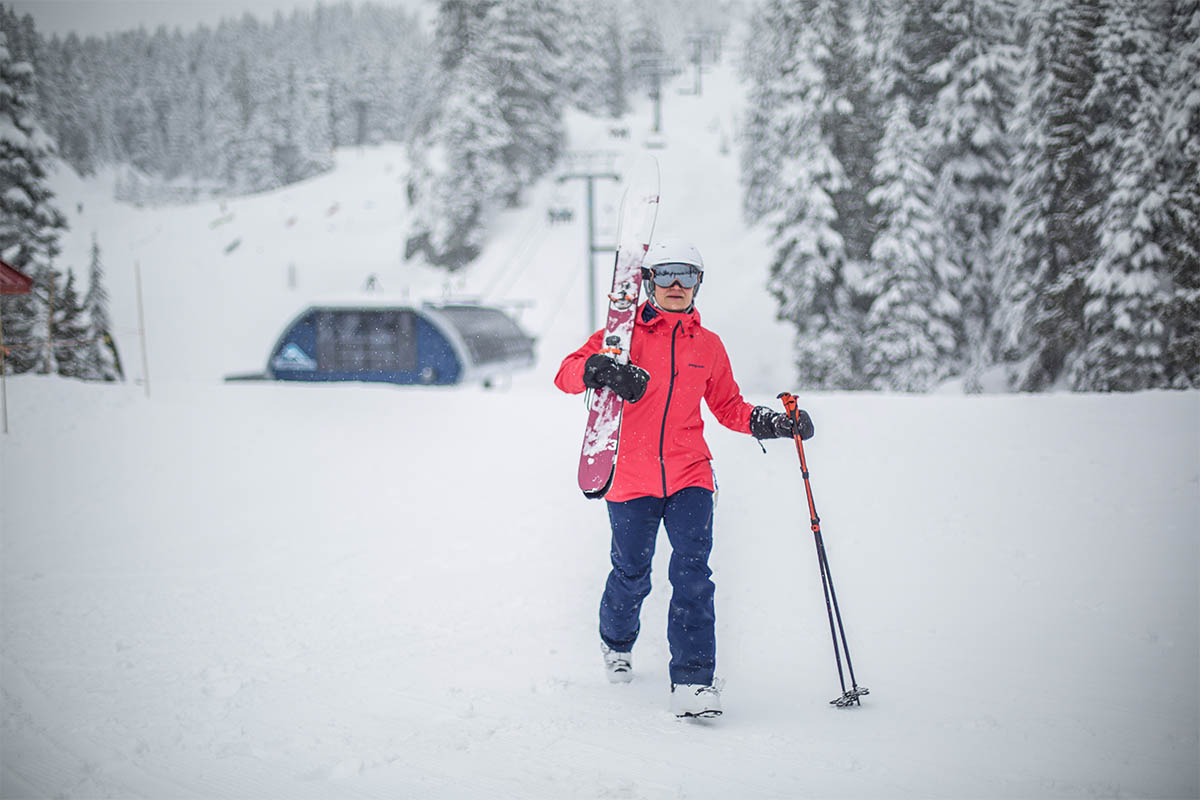
Enter the GripWalk sole, which has a rockered shape for a more natural stride and a softer plastic/rubber compound for improved traction. GripWalk soles are commonly found on higher-end boots that have an all-mountain focus (the extra grip is a big benefit on sidecountry hikes), although they’re becoming more common each year. If you go the GripWalk route, you’ll want to verify your bindings are compatible (be on the lookout for an ISO 23223 designation). The good news is that many alpine bindings are now multi-norm-ready (i.e., designed to be compatible with a variety of boots and soles-types), including popular models like the Marker Griffon, Look Pivot, and versatile Salmon S/Lab Shift (which is also sold under the Atomic name). See our ski boot and binding compatibility guide for more detailed information on how to pair boots with bindings.
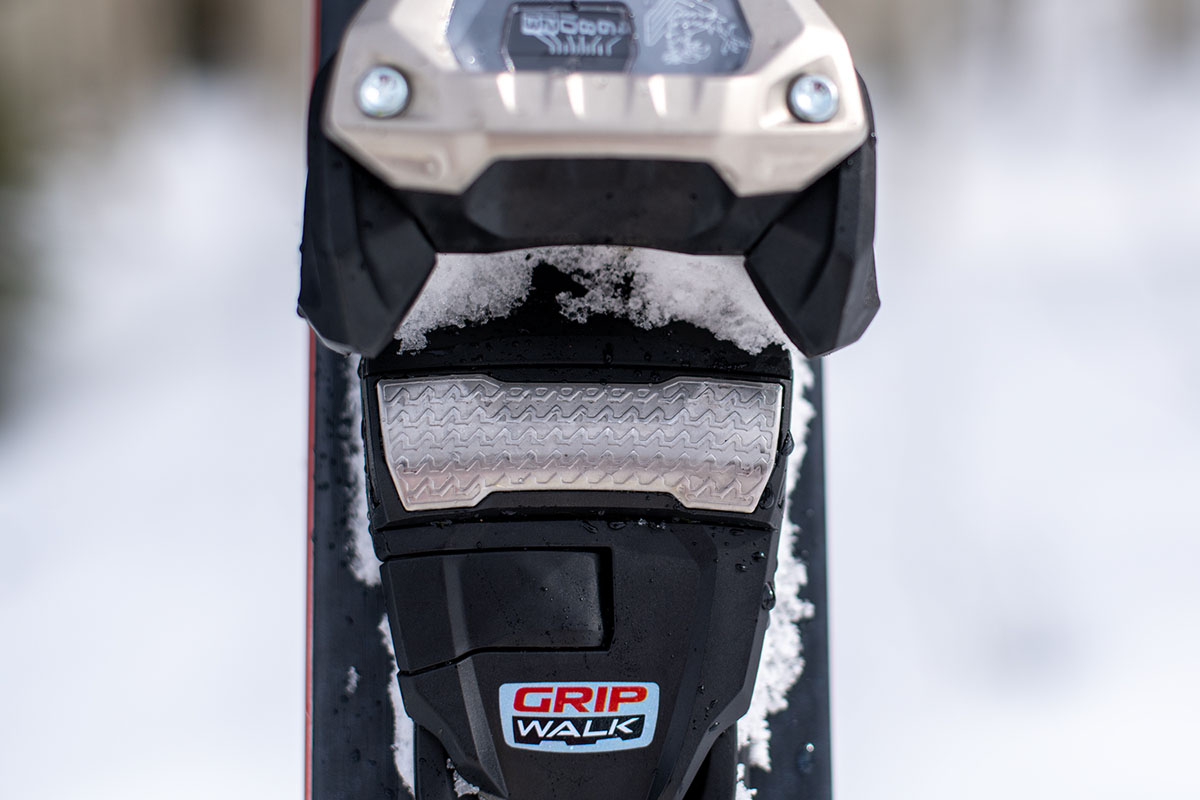
Until recently, the weight of a downhill ski boot was largely ignored (it’s still not listed as a spec on many retailer websites). But with the dramatic growth in backcountry and sidecountry skiing—and an increased spotlight on weight in general in the outdoor gear world—we’re starting to see the same lightweight focus in the downhill ski boot market. The benefits of lighter footwear for uphill travel and bootpacking are obvious: You have less weight to move with each step. With that in mind, it comes as little surprise that tech binding-compatible (read: backcountry-ready) models like the Scarpa 4-Quattro XT and Dynafit Radical Pro are some of the lightest on our list. But even for those riding the chairlift, lightweight boots can make it easier to control and maneuver your skis in tight spaces like bumps and trees and reduce fatigue in your legs on long days.
That said, we don't expect to see ultralight boots take over the resort market anytime soon. Downhill boots are heavy for a reason: The substantial linings provide excellent insulation, the relatively thick shells are quite durable and transfer power well, and quality aluminum parts on the buckles inevitably add weight. In the end, unless you're a big off-trail explorer, we don't recommend putting much stock in a trimmed-down design.
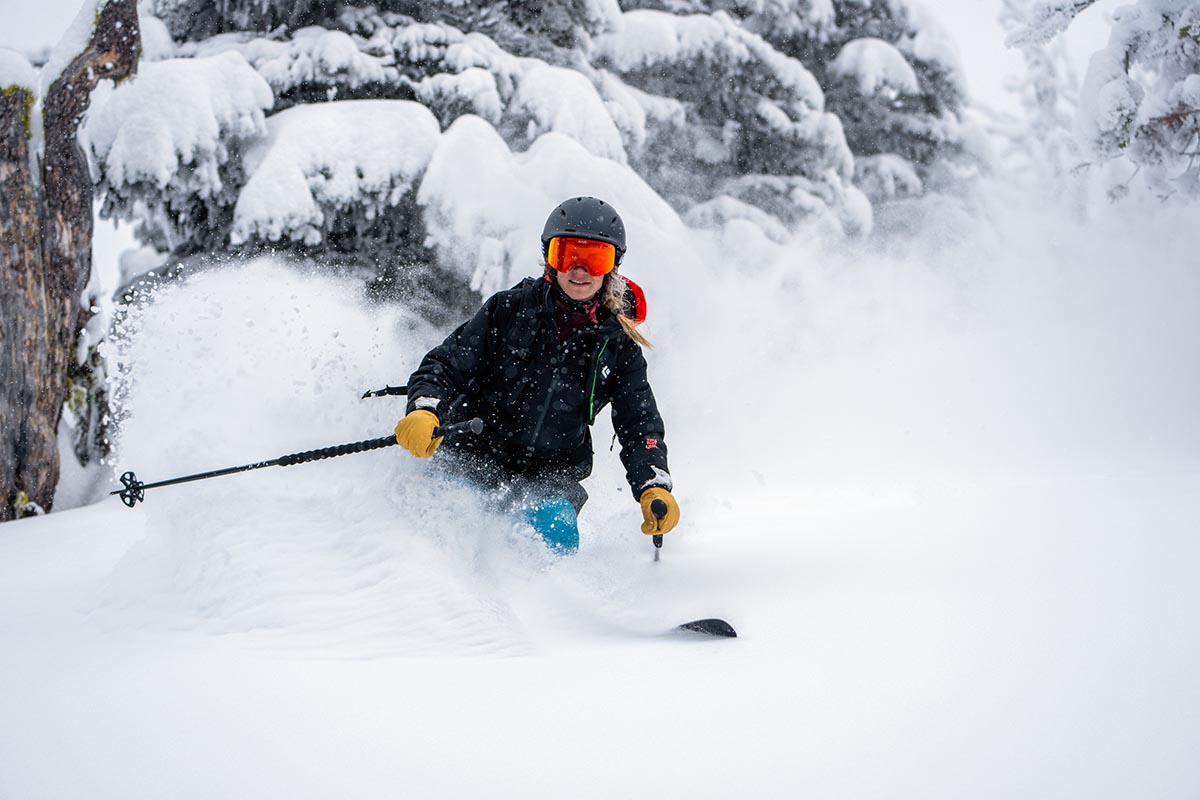
A growing number of downhill boots include a walk or hike lever (usually located roughly at your heel) for added flex and comfort, whether you’re trekking from the car to the resort or venturing into sidecountry terrain. In reality, these modes don’t have the necessary range of motion to be fully comfortable when walking long distances or uphill for extended stretches (select a true backcountry-ready design like the Tecnica Cochise 95 W DYN or Fischer Ranger 115 DYN if that's a priority). However, the walk feature will appeal to folks who primarily ski downhill but want the option to do some booting to access inbound or sidecountry terrain. Many skiers will also appreciate it when climbing the stairs to the lodge or walking across the parking lot after a long day on the hill.
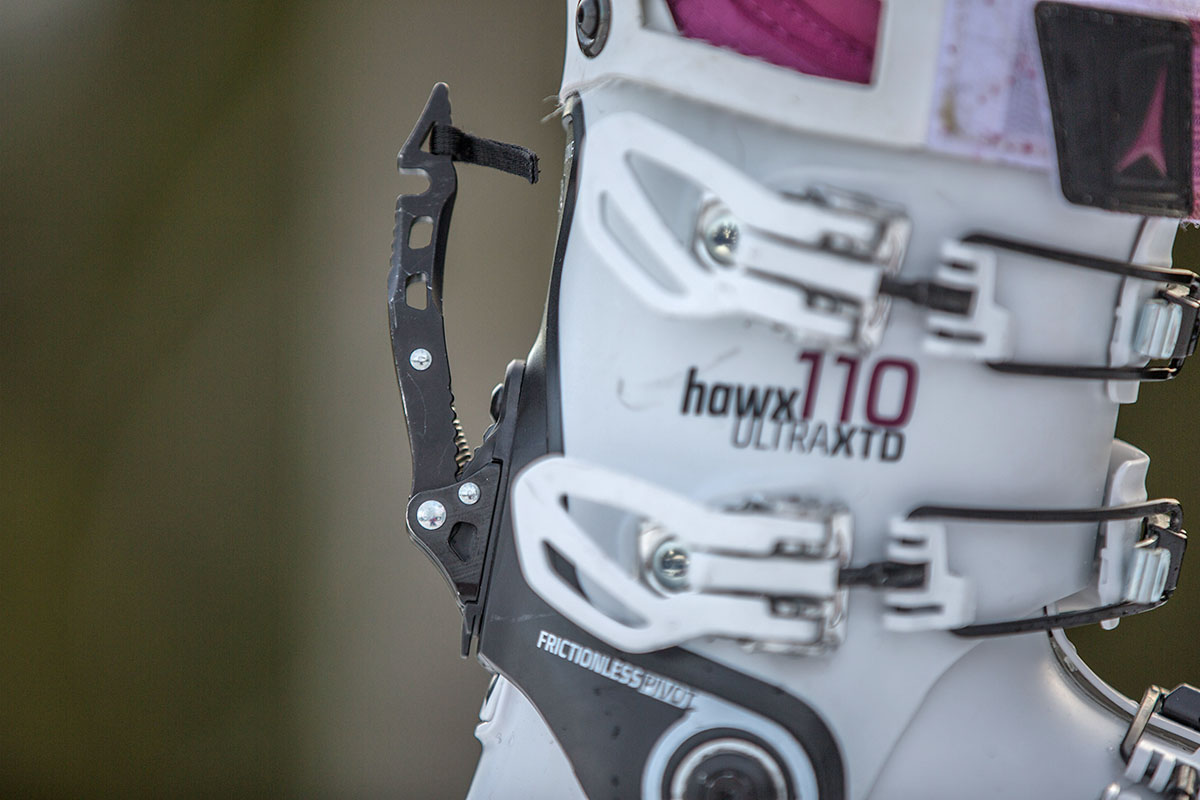
For women who run cold or primarily ski in frigid areas like the upper Midwest of the U.S., it may be worth considering a boot with an integrated heated liner. Many reputable manufacturers offer designs that fit this bill, including K2, Rossignol, Nordica, and others. For example, Rossignol sells a heated version of their Pure Pro above called the Pure Pro Heat. The technology is fairly consistent across the industry: The boot is outfitted with the requisite heating elements and includes a control panel that allows you to adjust the temperature of the liner, which can then be recharged via USB.
In terms of downsides, keep in mind that you’ll pay for the added feature in cost, weight, and a bit of bulk, and built-in liners do add a little more complexity to the overall construction of your boot. But for those with chronically cold feet or who frequently ski in well-below-freezing temperatures, those drawbacks may be worth the boost in warmth and all-day comfort. As an alternative and one-time investment, it might be worthwhile to consider a pair of heated socks.
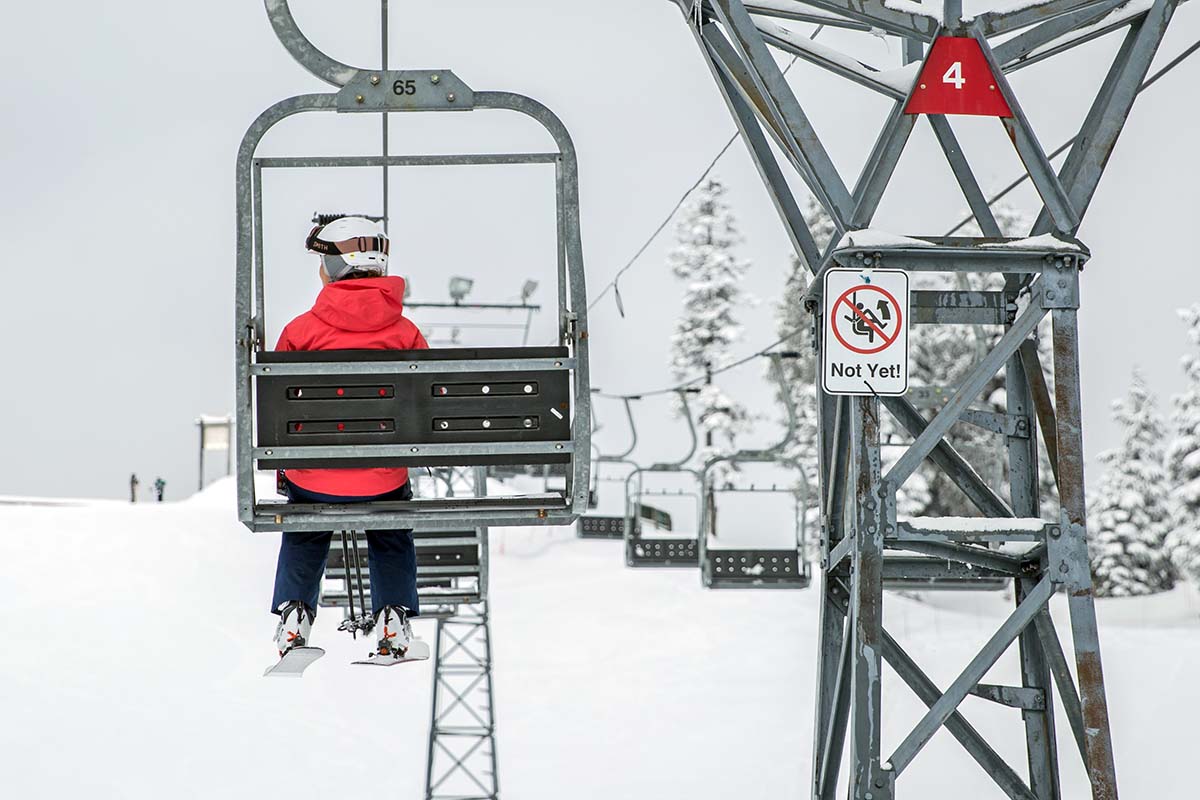
Backcountry skiing has exploded in popularity in recent years, and many downhillers are adding an alpine touring setup to their quiver. To help make things easier, there are a growing number of crossover boots that perform well on both resort days and while touring, including models like the Tecnica Cochise 95 W DYN and Fischer Ranger 115 DYN. Both have sturdy flex ratings (up to 115 at the stiffest end) but are light enough and boast tech fittings and a walk mode with a decent range of motion for occasional uphill use.
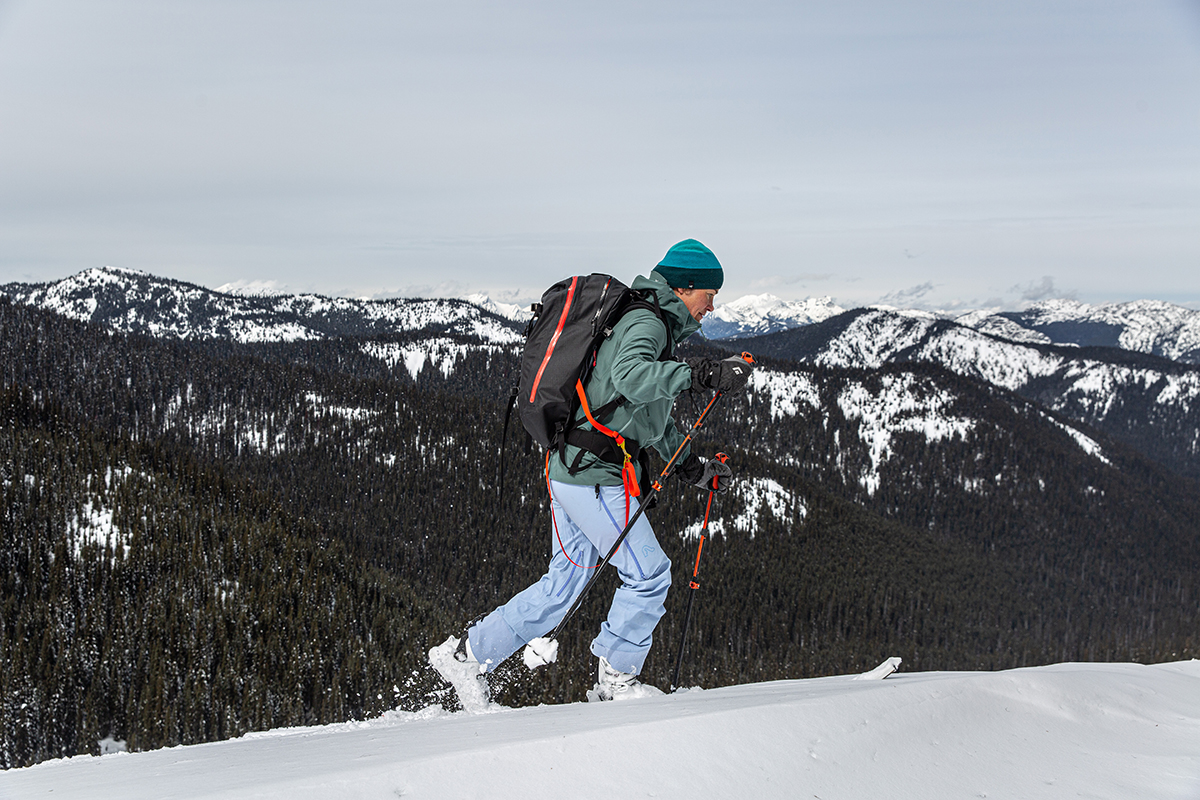
That said, if you plan to use your boots primarily at the resort, there are some compromises to be aware of. The lightweight construction of a hybrid boot isn't as warm and sacrifices some precision when carving on hardpack, and they can feel harsh in choppy conditions compared to downhill-only models. Additionally, crossover boots are heavier than the vast majority of specialized backcountry designs—often by a pound or more for the pair. But if you don't like the idea of buying two sets of pricey boots or only plan on touring a few times a season, the hybrid downhill/touring concept can be a logical move.
Today's ski socks reflect the improvements made in boot liner technology. You no longer need a thick, heavy-duty sock, and the market is now full of thinner (light- to medium-weight) options. Modern boots are better insulators and far more comfortable than they were a decade or two ago, which places less importance on the thickness of your socks. The best options for skiing are either merino wool or synthetic, and if you can swing the added expense, wool is our preferred material for stink prevention and temperature regulation. For a full list of options, see our article on the best ski socks.
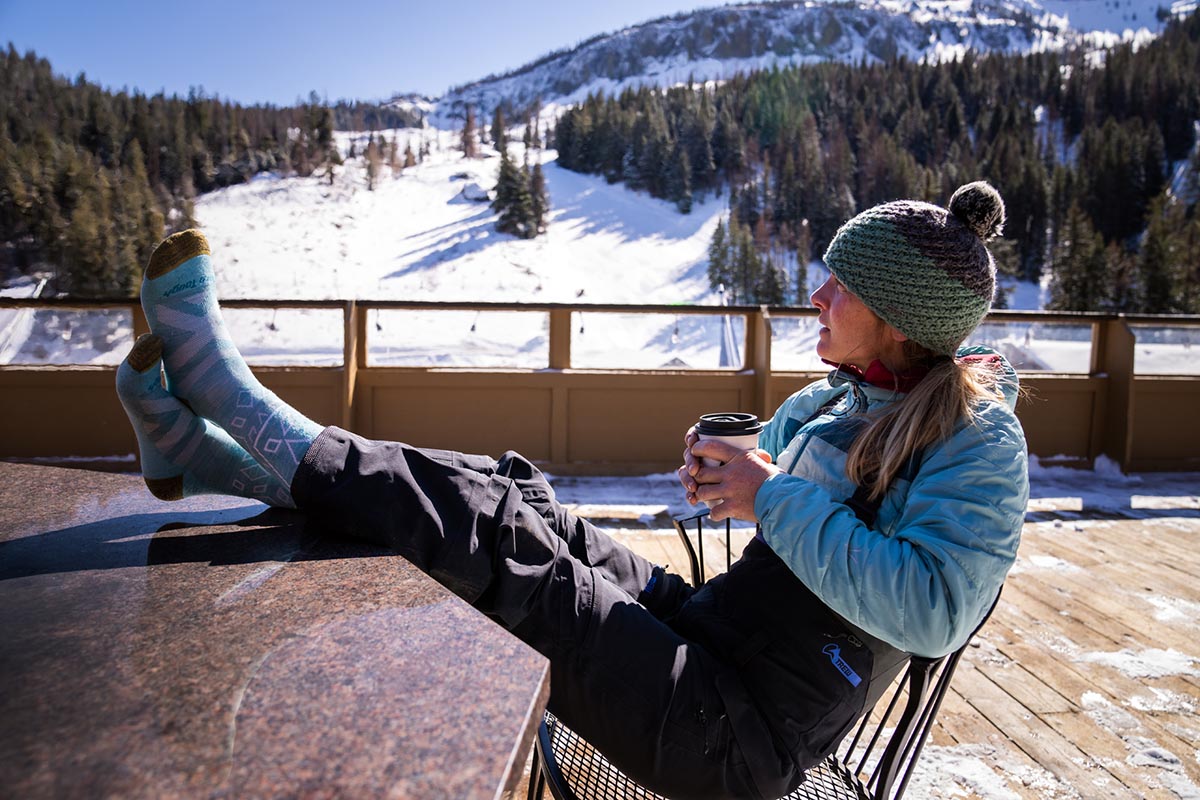
Boots are a great place to start in assembling your ski kit. For one, it hopefully means you get the pair that fits you best. It also should help guide the rest of your buying considerations. If you choose an advanced boot, you should pick out a correspondingly aggressive binding and ski that can help deliver the performance the boot is capable of. A stiff boot transfers power very efficiently as long as the binding and ski are capable of responding to those inputs. And as we mentioned above, don’t forget to ensure your boot’s sole (ISO 5355 or GripWalk) is compatible with your binding. To help get you properly outfitted, our picks for the best women's all-mountain skis and ski bindings are organized in a similar fashion as boots, broken down by ability level and terrain.
Back to Our Top Women's Ski Boot Picks Back to Our Women's Ski Boot Comparison Table